Add your feed to SetSticker.com! Promote your sites and attract more customers. It costs only 100 EUROS per YEAR.
Pleasant surprises on every page! Discover new articles, displayed randomly throughout the site. Interesting content, always a click away
Gambinos Bakery
World Famous Bakery & King Cakes Since 1949Unraveling the Once-Disastrous, Now-Delicious History of Saint Joseph’s Day 12 Mar 2025, 8:32 pm
Just because Carnival season is over doesn’t mean the unique holidays celebrated in and around New Orleans suddenly come to an end. In fact, Saint Joseph’s Day is just around the corner.
The celebration, taking place on March 19 each year, is commemorated around the world. In southeast Louisiana, it is primarily enjoyed by the region’s large Sicilian population. Here, parades take place on the weekends surrounding Saint Joseph’s Day. Meanwhile, on the day itself, churches, family homes, Sicilian-American businesses, grocery stores, and even a bar or two create beautiful, elaborate Saint Joseph’s Day altars covered in delicious food.
We are no stranger to such altars at Gambino’s Bakery. Over the decades we’ve hosted hundreds of volunteer bakers and altar-makers as they create—for one example—thousands of fig rolls for their annual Saint Joseph’s Day altars.

It’s a special tradition for Sicilians in our city, and increasingly, for the city-at-large. So where did the holiday come from and how did it make its way to New Orleans? We’ll explore those questions below.
Pious origins
Saint Joseph’s Day isn’t only honored in Sicily and New Orleans. Throughout Western Christianity, the holiday is also known as the Solemnity of Saint Joseph or the Feast of Saint Joseph. It is the major feast day of Joseph, the legal father of Jesus Christ and husband to the Virgin Mary.
By the 10th century, the calendars of several countries under the Western Christian Church held March 19 as their day to remember this important figure of Christianity. The day was made official in Rome by 1479.
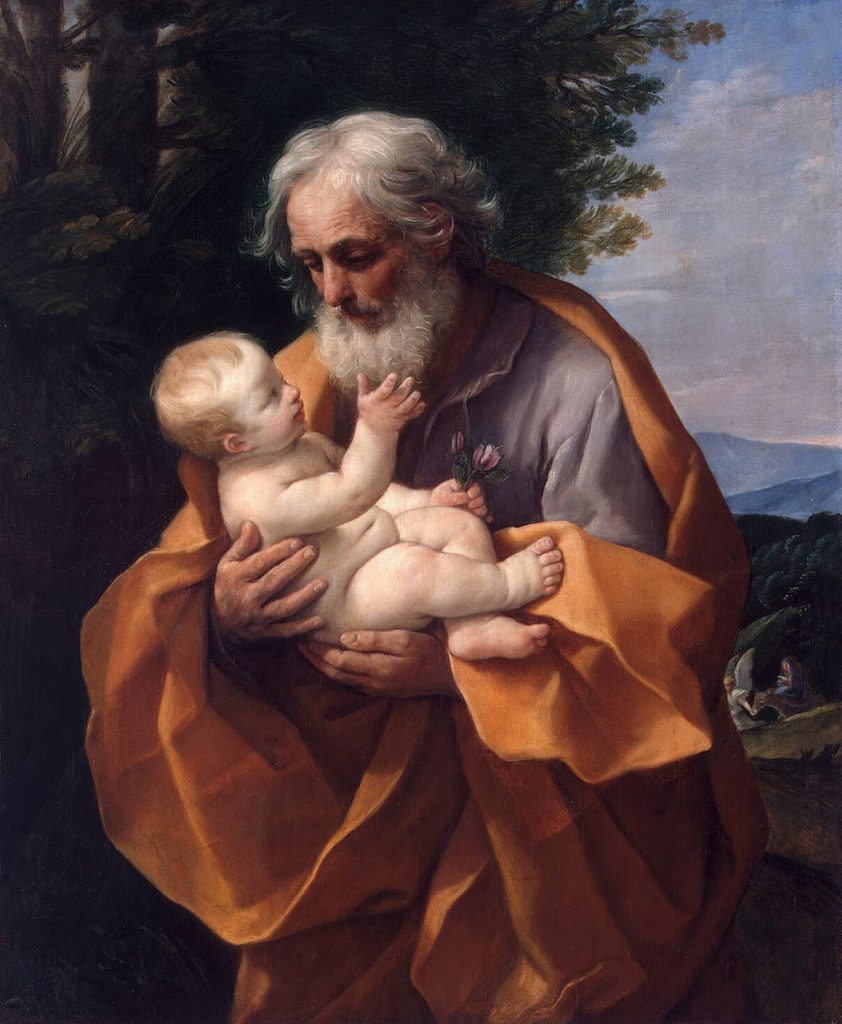
Commemorations around the world
The holiday is celebrated differently in various Christian communities across the globe. In some places, for example, the day is an opportunity to celebrate people or schools and parishes with names such as Joseph and Josephine. In other places, carpenters—Joseph’s profession—are recognized.
In Poland and Canada, Saint Joseph is considered both country’s patron saint, or divine protector. As a result, special masses are held, hymns are sung, and in Poland, the day is considered a major feast.
In contrast, in some Catholic countries such as Italy, Portugal, and Spain, because Joseph was considered a model father, the day is treated like America’s Father’s Day. Spanish children cook their fathers breakfast (no meat, of course, because it’s Lent) and symbols of the holiday include Jesus holding Joseph’s carpentry tools.
Some families in certain rice-producing regions of the Philippines practice the ritual of holding a banquet for a faux Holy Family. An old man, a young lady, and a small boy—sometimes chosen from among the community’s poor—are the guests of honor. They are sat around a table with the host family’s finest silverware and china and are sometimes even spoonfed a variety of courses by more well-to-do dinner attendees. After the dinner, they are given donations as a thank you gift for participating in the ceremony.
That idea of taking care of the poor is important in understanding how Saint Joseph’s Day traditions eventually found their way to New Orleans.
Fighting starvation
Memorable traditions surround Saint Joseph’s Day in Italy. In some parts of the country, bonfires line entire coasts with zeppoles fried on the flame. In other areas, pasta dishes with chickpeas are shared. It’s common in places to see people wearing red-colored clothing or to carry dried fava beans that have been blessed.
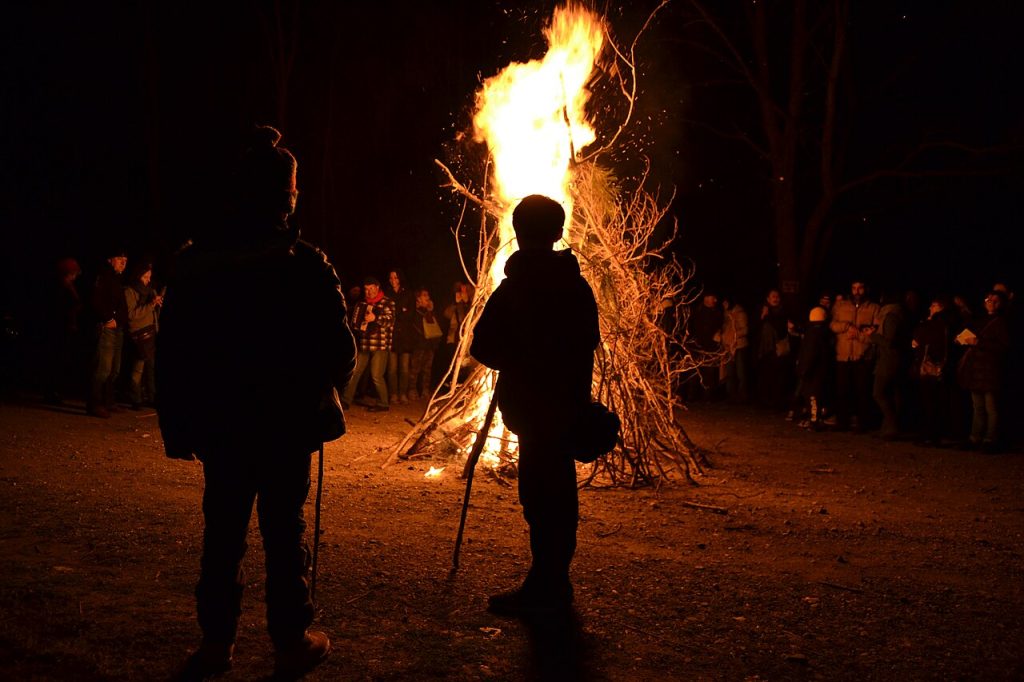
But perhaps no region of Italy has as special of a relationship with the Feast of Saint Joseph as the southern island of Sicily. That relationship began in the Middle Ages when legend says a severe drought hit the island, resulting in terrible famine. The Sicilians prayed to God, promising if He answered their prayers through their beloved Joseph, they would prepare a feast in his honor.
Legend has it that the rain came, with fava beans sprouting and saving the island from starvation. The fava bean has since played a consistent part in Saint Joseph’s Day customs.
So to has the feast the Sicilians promised to God and their patron saint. Each year, on March 19, Sicilians unveil large and prominent Saint Joseph’s Day altars, decorated with figurines, medals, votive candles, flowers, and so much food and drink. Limes, fava beans, elaborate cakes, breads, cookies, zeppole, and a host of Lenten meat-free dishes adorn the table. And, because Joseph was a carpenter, traditional Saint Joseph’s Day foods often have bread crumbs to signify the sawdust produced from his work.
Of course, Sicily isn’t the only place that features Saint Joseph’s Day altars!
Coming to New Orleans
Between 1880 and 1920, at least 300,000 Italians—primarily Sicilians—immigrated to the New Orleans area. They brought their traditions with them, one of which being Saint Joseph’s Day and its altars.
While these altars appear to be fading from popularity in other Sicilian-American communities, they are still going strong down here. A search from a recent year revealed more than 75 altars set up on March 19.
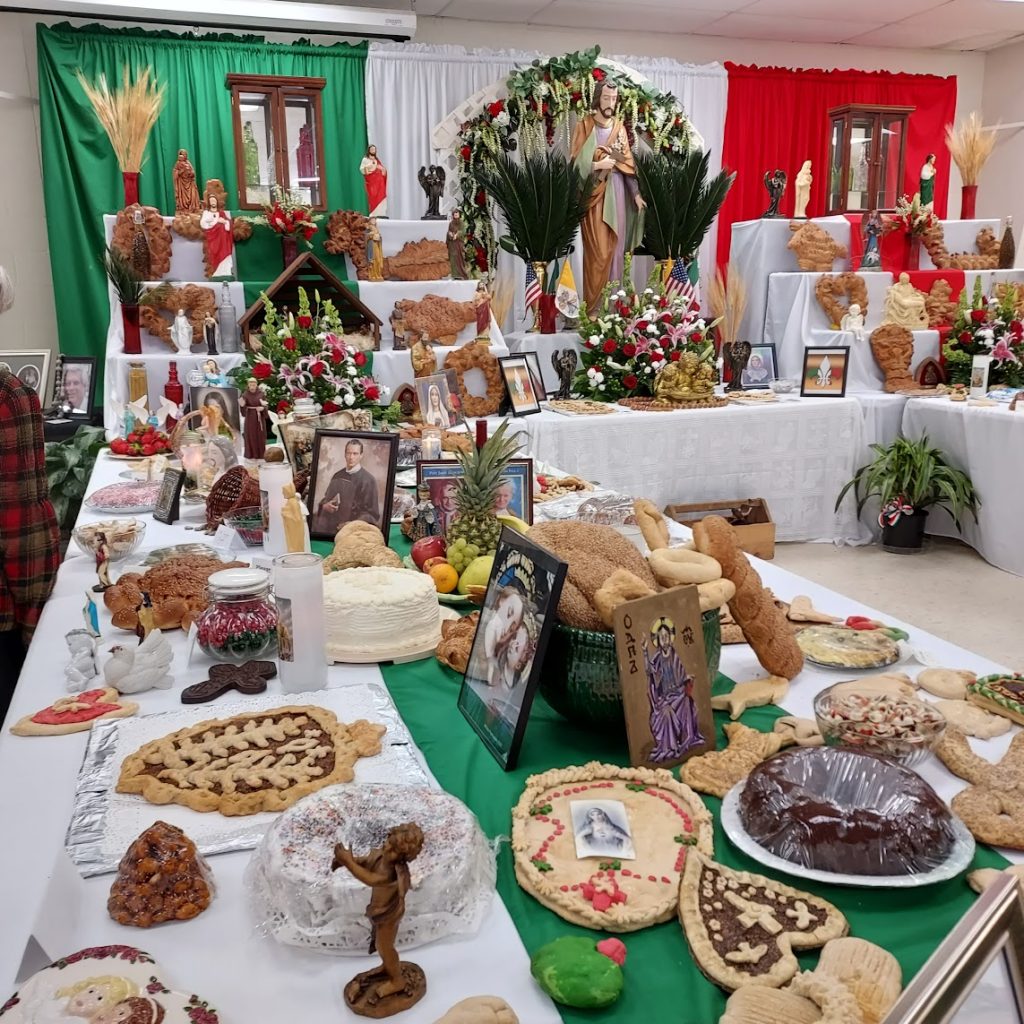
These are truly works of art and amazing demonstrations of culture. Best of all, one need not be Catholic or Sicilian to enjoy them. Take a look at a local newspaper article the week before the holiday to see who will have publicly viewable altars this year.
Most Saint Joseph’s Day altars have three components to them. One is the statue of Saint Joseph. Another is the decorations, similar to what one would find in Sicily: flowers, candles, figurines, medals, and other items make the altar. And finally—an easy favorite for many—there’s food.
Oh, the food! Just like Sicily, there are cookies, cakes, and bread. Many of these are often baked in religiously symbolic shapes such as shellfish, lambs, crosses, hearts, hammers, doves, and more. There are, of course, fava beans, which remind Sicilians of the divine breaking of the drought-induced famine. And there are lemons, which are also thought to bring good fortune (especially, it is said, for single women looking to find a husband).
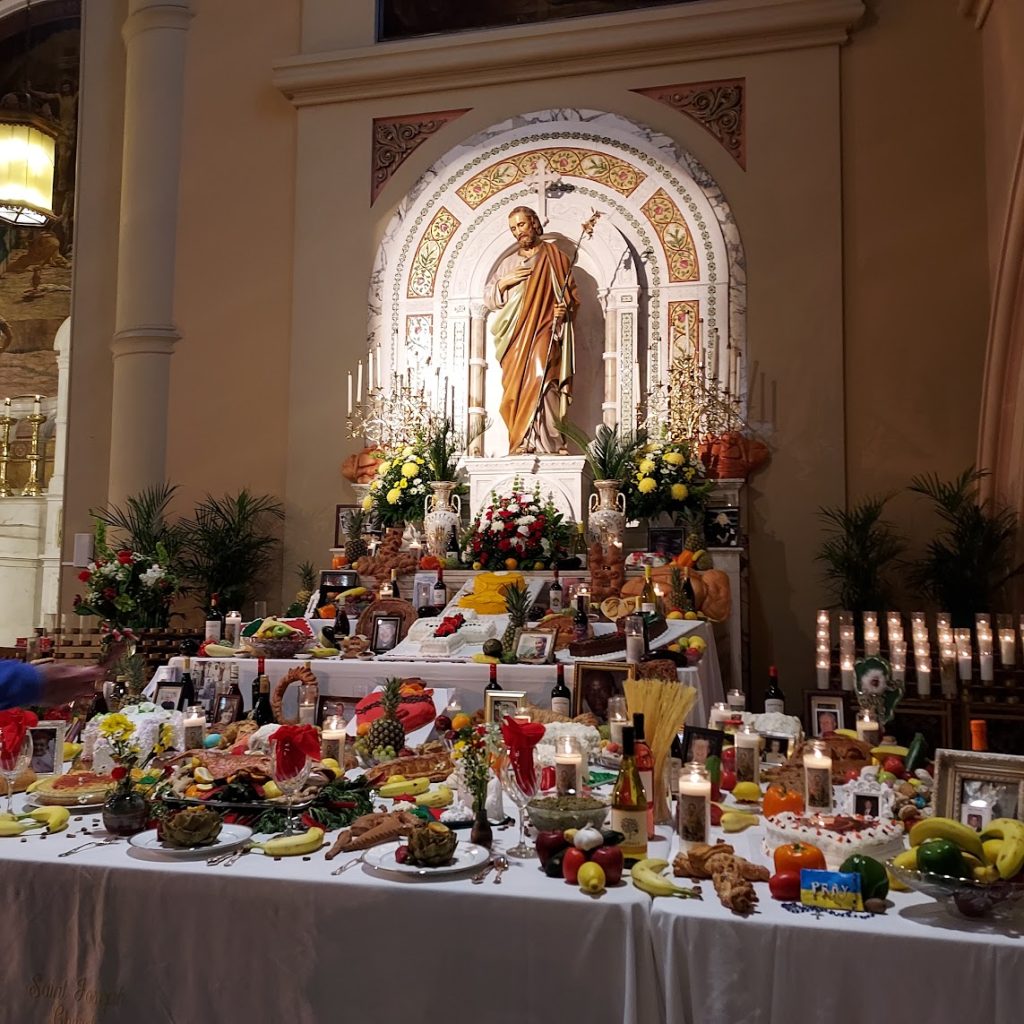
Usually food is free of charge or available for purchase. Sometimes you’ll be gifted a goody bag to take with you. And, in line with the Italian tradition of providing for the needy, leftovers are often donated to the poor.
Of course, if you’ve been here for Saint Joseph’s Day, you know that the altars aren’t the only way people celebrate the holiday in New Orleans. No fewer than four parades are held on the weekends surrounding March 19 by various local Italian-American societies.
And, in true only-in-the-Crescent-City fashion, there is also Saint Joseph’s Night, centered around the city’s Black communities. After the sun goes down, Mardi Gras Indians in full, colorful, self-made suits sing and dance through the neighborhood, delighting onlookers and searching for rival groups of Indians.
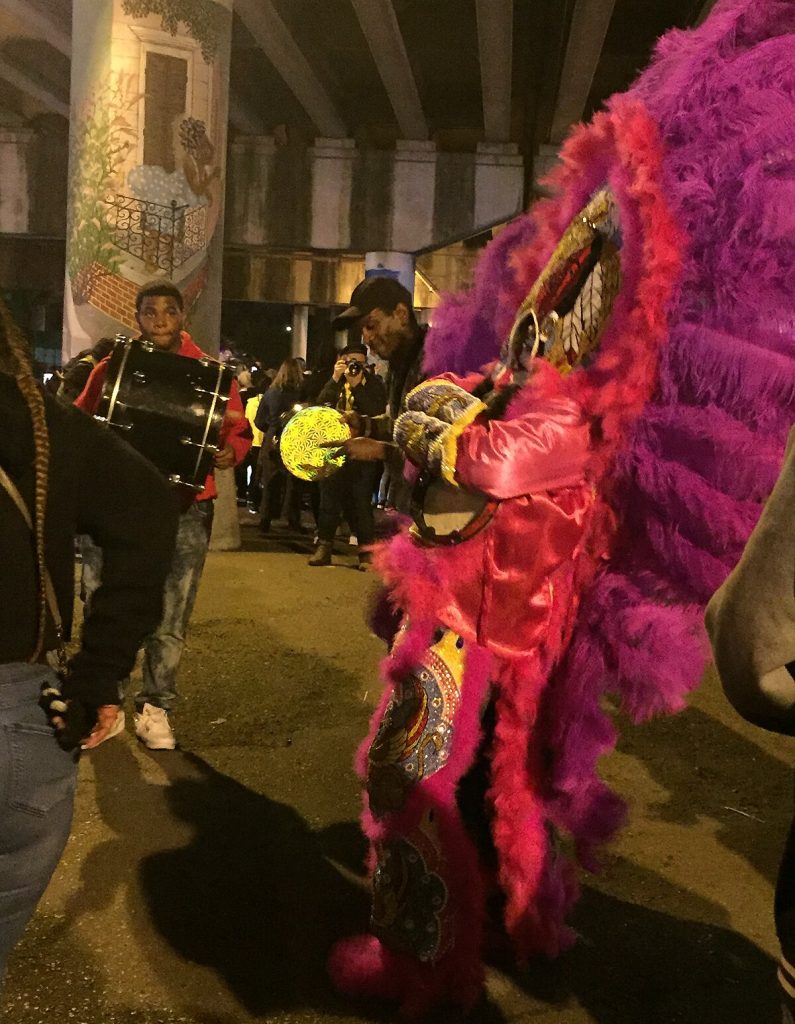
It’s not clear that this Mardi Gras Indian-focused tradition shares anything with the Sicilian traditions other than a date on the calendar, but both are amazing to witness.
No matter how you choose to celebrate your Saint Joseph’s Day (or Night), we at Gambino’s Bakery feel fortunate to be part of a region that is so cultured and vibrant.
The post Unraveling the Once-Disastrous, Now-Delicious History of Saint Joseph’s Day appeared first on Gambinos Bakery.
You think you know Mardi Gras? How about Cajun Country’s Courir de Mardi Gras?! 11 Mar 2025, 6:55 pm
Carnival is here again and many of us who have been in the area for a while consider ourselves to be a bit of a Mardi Gras expert.
That’s fair—at least as it pertains to the Greater New Orleans Area. As you may be aware, only two-and-a-half hours west on Interstate 10, there’s a Mardi Gras unlike anything we see in the 504.
Out in Cajun Country—the small towns surrounding Lafayette—Mardi Gras is called Courir de Mardi Gras (which translates to “Fat Tuesday Run”). Their traditions are down from the rural areas of Catholic medieval France. Many of those traditions originated in Celtic Europe and have unexpected ties to Halloween.
Participants wear masks and costumes to conceal their identity as Courir de Mardi Gras is an opportunity to overturn social conventions by pretending to be something you’re not (a woman instead of a man, for example, or poor instead of wealthy). Costumes are colorful patchworks of different materials because French peasants couldn’t afford new costumes and resorted to using remnants of whatever cloth was laying around. The pointy hats popular for the event were originally a chance for the poor to mock the traditional headwear of wealthy French women.
Being so late in winter, the poor in medieval France would be low on food, and would use the festival to gather in groups and visit the homes of the wealthy—offering to perform and entertain in exchange for food or money, a tradition similar to mummering. Today, Le-Capitaine and his co-captains lead the Mardi Gras (the name for the group of courir participants, and the only instance in which “Gras” has a hard “s” sound) through their town, stopping at houses and begging for food that can be used in the communal gumbo to be made later in the day.
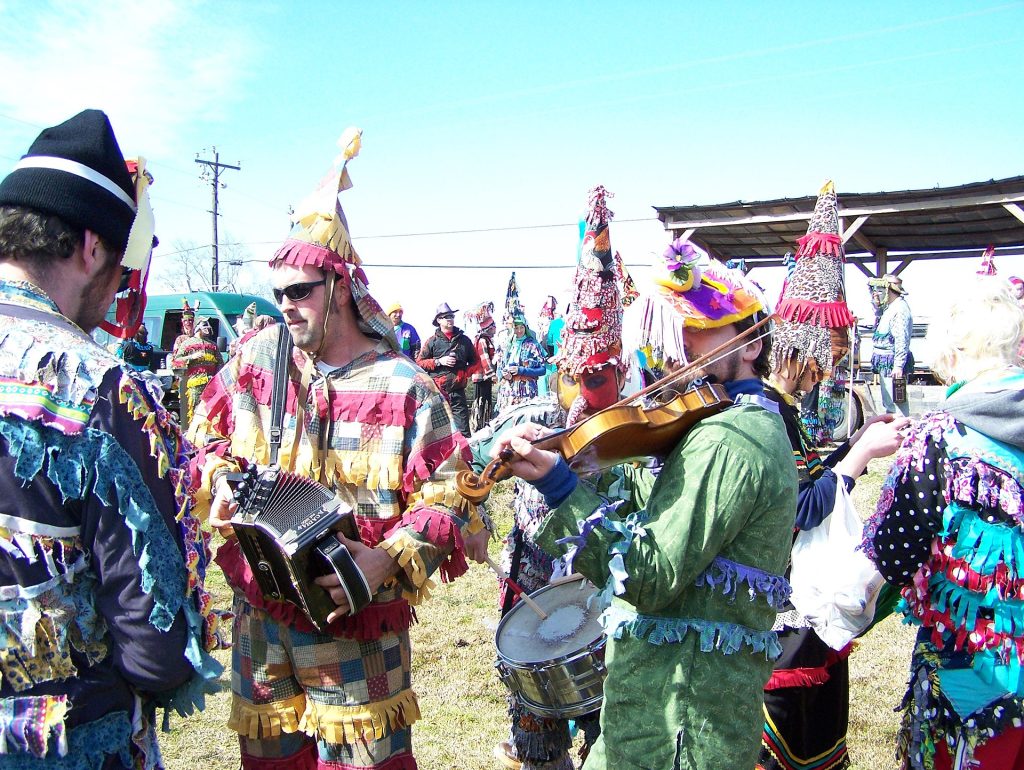
Entertained homeowners often donate a chicken or two, with one catch: the chicken is alive and the Mardi Gras is forced to chase said chicken through muddy yards and fields. Some believe the running takes the place of races held during Mardi Gras in medieval France.
And that’s just the tip of the iceberg! Each town has their own celebration, and each celebration is a little different. Many are open to guests, but the more you want to participate, the more you’ll need to honor these traditions that are truly unique to the world!
As a proud Cajun Country bakery with a Gambino’s shop in Lafayette, we wanted to share some of the towns throwing amazing, one-of-a-kind celebrations each Mardi Gras.
Vermilionville Courir — Preserving Tradition
Head Vermilionville, the cultural arm of Bayou Vermilion District, to experience a traditional Mardi Gras run Sunday, February 23, 2025. The whole family can participate in this interactive event where the Basile Mardi Gras Association shares in the medieval tradition of the Courir de Mardi Gras. Disguised revelers, led by Le Capitaine and singing La Chanson de Mardi Gras will make their way through the historic village begging for the ingredients to make a gumbo.
The event will begin at 10 a.m. with a screening of Pat Mire’s iconic Mardi Gras documentary, “Dance for a Chicken,” which reveals the secrets and history of the rural Mardi Gras run or Courir. At 11 a.m., musician Kevin Rees will demonstrate the use of the “Chanson de Mardi Gras,” with the attendees.
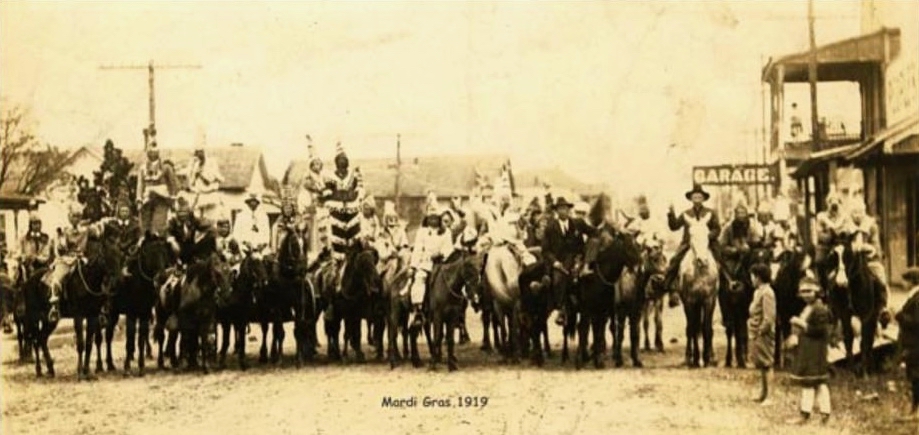
At 11:30 a.m., the Basile Mardi Gras Association will begin the run through the historic village and will end with the famous chicken chase for children. After the run, grab a delicious lunch at Vermilionville’s restaurant, La Cuisine de Maman, then join the party in the dancehall for live music from the Pine Leaf Boys, 1 p.m. – 4 p.m. There will be king cake tasting and a Capuchon (traditional pointy hat) craft for the kids as well.
Choupic — More Beatings than Beads
This small town’s Mardi Gras tradition centers less around beads and more around beatings. In fact, in Chopic you won’t even find horse riding and chasing chickens. Here, it’s all about chasing children and flogging them with willow tree branches (and occasionally the flexible end of a fishing pole).
We know it sounds rough, but the day’s all in good fun and the “flogging” is more of a simulation of past traditions. The whipping can be traced back to the burlap whips used in Brittany — where Acadians were originally from — in Pre-Christian Celtic Europe. In the medieval period, flagellants would walk through the streets whipping themselves and the occasional onlooker to beat the sin out of them.
That’s basically the idea today, except—and we must stress this—nobody gets hurt. In Choupic, unmarried men (usually from 16 through their 20s) secretly organize the run and don’t disclose the location to anyone (though Possum Square seems to be a popular meeting point). They meet early on Mardi Gras morning, and then move from one residential area to the next, chasing after kids. When caught, the kids are made to recite their Catholic prayers before receiving their pre-Lenten flogging.
Again, details of the run aren’t released, so stay alert if you want to get a peak of this ancient (and fun—really, no one gets hurt!) tradition.
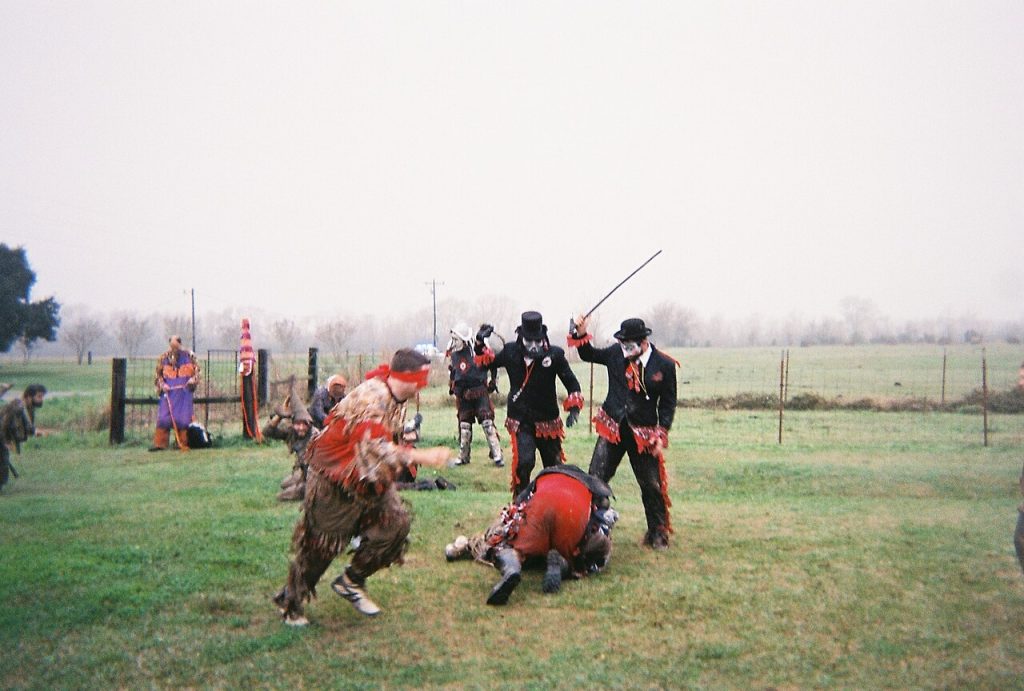
Church Point — Among the Best
In 1961, representatives from Mamou and Church Point flipped a coin to see who would have their courir on Mardi Gras Day. Mamou won and, since then, Church Point has celebrated a couple of days before, on Sunday.
It’s actually a two-day event these days. Saturday’s all about the kids. There’s a run for children—excluding alcohol and horses, but maybe not chickens—and then an afternoon parade. You can find details here.
Sunday is…well…is not all about the kids. Only men are allowed to run — though women and children are allowed to participate in the trail ride that follows the runners.
Costumes (required to run), chickens, pigs, gumbo, alcohol, live music…it’s all in Church Point at what many claim is one of the best traditional Mardi Gras around. In many towns you’ll hear the traditional “La Danse de Mardi Gras” sung. The tune is a melody from the Bretons in the northern coast of France, though the lyrics vary by town. The beginning of the Church Point version translates to the following:
“The Mardi Gras come from everywhere around the hub.
Once each year to ask for charity.
An old potato, a potato and some cracklins.”
Elton — Smalltown and Intimate
This small back country town near Eunice hosts their own courir with runners going house to house offering to perform their Danse de Mardi Gras in exchange for chickens for gumbo, or nickels for rice.
Their run takes place on Saturday, March 1, and you can find information about registration, fees and the route in their Facebook group.
Eunice — One of the Biggest!
Eunice’s courir is one of the biggest around with approximately 2,000 participants — both men and women — running on Mardi Gras day. But festivities actually start on Friday, February 28, kicking off five days of live Cajun music and jam sessions, drinks, local food and general reverly. You can find a full schedule of activities on this page.
There are full boucheries (a whole-hog butchering that provides cracklins, boudin, backbone stew and much more) on Sunday morning, plus a highly recommended fais do-do sessions during the evenings.
Tuesday’s the big show. Costumes are required for the run, and the route is 13 miles long! Runners ride on trailers (get there early to get a spot!), travel on horseback, or walk, stopping at farms along the way to offer a dance in exchange for gumbo ingredients and nickels. The group returns to town for a parade by about 3 p.m. and then more music.
If you’d rather watch the courir, rather than take part in it, that’s an option, too. And there’ll be plenty of music to keep you having fun downtown while you wait for the group to return.

Gheens — More Whipping and Close to NOLA
Mardi Gras festivities in Gheens are a lot like the flogging traditions in Choupic, but not quite as secretive. The small town is also just an hour’s drive away from New Orleans, so it might be a little more accessible for those looking for a shorter trip.
The oldest of Gheens’ residents say the tradition existed when they were children, and— because there aren’t written records documenting the early whipping—it’s impossible to say when exactly the rituals began.
Today, teenage boys and young men dress in costume (sometimes scary, sometimes resembling Mardi Gras costumes we’re more familiar with) and are given bells to pin on their clothing. They meet near the Company Canal and the old Gheens family plantation in a field at the back of the town and load into trucks.
The group rides along Hwy-654, tapping their willow whips as a warning to children. The bells jingle, and the young men and younger boys taunt one another until the wagons arrive at a house and the chase begins. Younger children being chased have two choices: they can fall to their knees, yelling “Pardon! Pardon!” for mercy, or they can continue to try to run from the masked attackers (who do not give up easily).
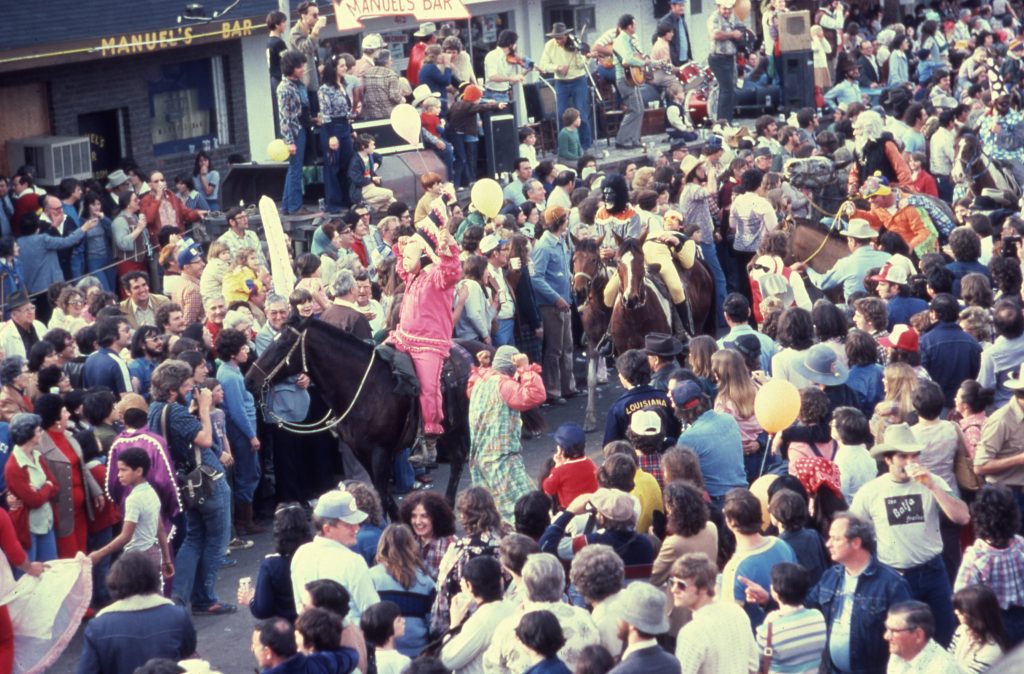
It sounds wild, and it is…but it’s also a lot of fun, and a beloved tradition.
Later in the morning—by about 11 a.m.—a parade begins, featuring homemade floats that attract visitors from several other towns in the region.
Mamou — One of the Most Famous
Mamou has another of the more popular Mardi Gras runs, made even more famous when the late Anthony Bourdain documented his visit to the town’s Cajun Mardi Gras for an incredible and inspiring episode in his “Parts Unknown” series.
The celebration starts on Saturday with local Cajun bands like Steve Riley and the Mamou Playboys, but things go up a notch on Monday night with a popular street dance lasting until 11 p.m.
The town’s back up at daybreak the next morning to get ready for the run, which takes off at 8 a.m. from the American Legion Hall on Main Street. Only costumed men are able to participate in the run, though women are allowed to watch. For men who don’t have their own horse, wagons and trailers are usually available to ride on.
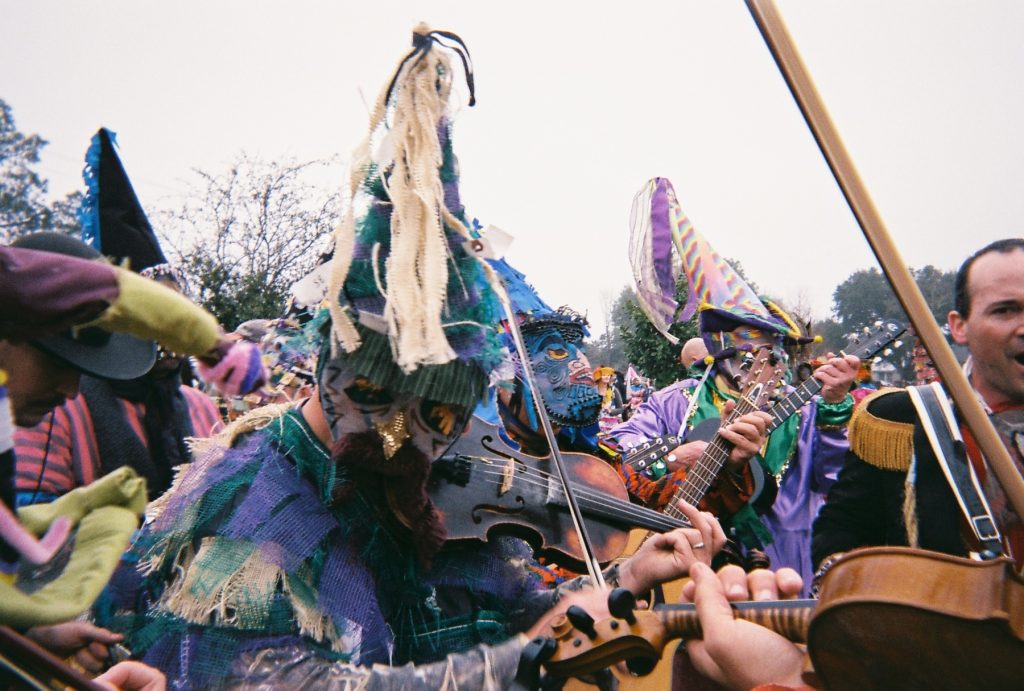
While chickens are chased and pranks are played by the runners, a block party revs up downtown near the legendary Fred’s Lounge.
A full schedule is available here.
Mermentau Cove — A Weekend Earlier for Those Wary of Missing NOLA’s Mardi Gras
If you don’t want to leave town during the last weekend leading into Mardi Gras, then Mermentau Cove holds their Courir de Mardi Gras the week before — this year on February 22. The traditional run starts at 8 a.m., making several stops along the back roads to private homes and Istre Cemetery.
The day finishes with a fais do-do and a gumbo, and all are invited to attend! You can find details about the event here.
If you’d like to participate in the run, you’ll need to be costumed, and be a man at least 17 years old (women and children can only attend the fais do-do in the evening). To run, you must attend a meeting in advance which would mean a separate trip out to Cajun Country.
Soileau — Creole All the Way
The small, rural community of Soileau (affectionately referred to as “Metro Soileau”) hosts one of only a few Creole (as opposed to Cajun) Courir de Mardi Gras. The event is held on Lundi Gras, March 3, and starts at Metro Soileau (422 Highway 104, Oberlin, LA).
The day kicks off at 10 a.m. with a traditional run and trail ride (runners on horseback, music, chickens and everything else you could ever want from a courir), followed by a Zydeco dance and a gumbo feast back at Metro Soileau.
It only costs $20 per person, and all the information you need to join is on the event’s Facebook page.

Tee Mamou-Iota — For the Whole Family
The Tee Mamou Mardi Gras Folklife Festival is now in its 37th year, bringing several communities together to celebrate. There’s a children’s Courir de Mardi Gras that begins at 1pm and a parade at 2:30 p.m. There is also live music and entertainment throughout the morning and afternoon at this free fest, as well as tons of great local food available. (I have no idea what a “Syrup Pie” is, but I want it!)
Contact fest organizers here if you want to learn about running in the event, or if you have any other questions.
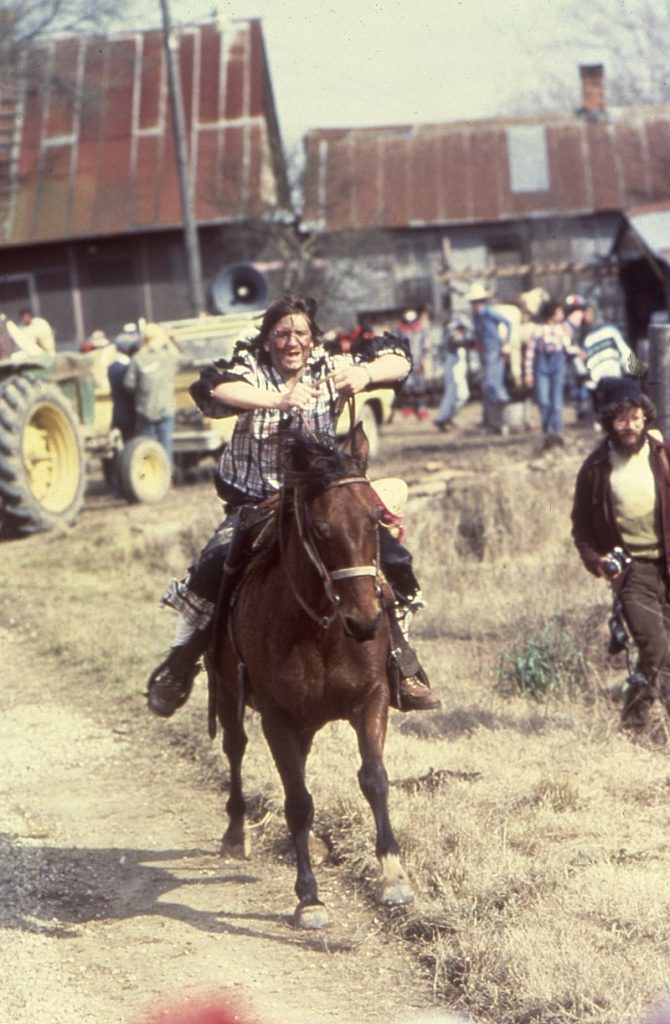
The post You think you know Mardi Gras? How about Cajun Country’s Courir de Mardi Gras?! appeared first on Gambinos Bakery.
From blackouts to blowouts and nail-biters to Purple People Eaters, New Orleans’ 10 previous Super Bowls have been full of memories 3 Feb 2025, 7:26 pm
On Sunday, February 9, New Orleans is hosting its record-tying 11th Super Bowl. If the previous ten New Orleans Super Bowls are any indication, it’s going to be a spectacle full of memorable moments.
In our previous post, we covered the events surrounding Super Bowl IV, the first time our city hosted the big game. It included a trash-talking newspaper editor, a halftime Battle of New Orleans reenactment, and even a hot air balloon crash!
In this article, we’ll look at the next nine times the Crescent City has played host to one of the world’s biggest sporting events. From unmatchable halftime shows to gripping on-field drama to an unexpected blackout, the Super Bowl in New Orleans is no stranger to thrills.
Super Bowl VI: January 16, 1972
Only two years after hosting its first Super Bowl, the Big Easy was awarded the opportunity to host a second time. Once again, the game was held at Tulane Stadium, as the Superdome was still years from being built.
Dallas and Miami were both considered heavy favorites to host the Super Bowl. However, New Orleans won a dark horse bid when it was pointed out that both the Cowboys and Dolphins (teams from Dallas and Miami) were also considered favorites to have successful seasons and reach the game. Owners were worried one of these teams would have a competitive advantage if they played at home so, on a 14th round of voting, New Orleans was selected.
The Cowboys and Dolphins did, in fact, make the Super Bowl and the main storyline was around how Dallas could never win the biggest game. They were called “Next Year’s Champions,” poking fun at how they could never seem to bring a trophy home.

The day was unseasonably cold. A kickoff temperature of only 39 degrees means it remains the coldest Super Bowl ever played. The Cowboys, however, were hot. They won their first championship in years—Super Bowl or otherwise.
Louis Armstrong, who had passed away just months earlier, was the theme of the halftime show. He was honored by an all-star cast of local musicians such as Ella Fitzgerald, Danny Barker, and Leroy Jones.
Super Bowl IX: January 12, 1975
This is the last professional football game ever played at Tulane Stadium as the Superdome was set to open the following season. It was a match-up between two future Hall of FAme quarterbacks, Terry Bradshaw of the Pittsburgh Steelers and Frank Tarkenton, as well as two renowned defenses: Pittsburgh’s Steel Curtain and Minnesota’s Purple People Eaters.
While we already mentioned that Super Bowl VI was the coldest Super Bowl ever played, this was the second coldest. And overnight rain produced slick conditions. In fact, this was the last time a Super Bowl would be played in inclement weather for 30 years!
The NFL’s championship game was gaining popularity, with The Mary Tyler Moore Show airing an episode about the Super Bowl—particularly betting on it. Jazz legend Duke Ellington had died the year before, so the halftime show was a tribute to the jazz composer, pianist, and bandleader. It featured the Grambling State University Band and Ellington’s own son.
As for the game, the pundits were right. It was a battle of defenses and only two points were scored in the first half. Ultimately, however, the Steelers beat the Vikings 16 – 6.
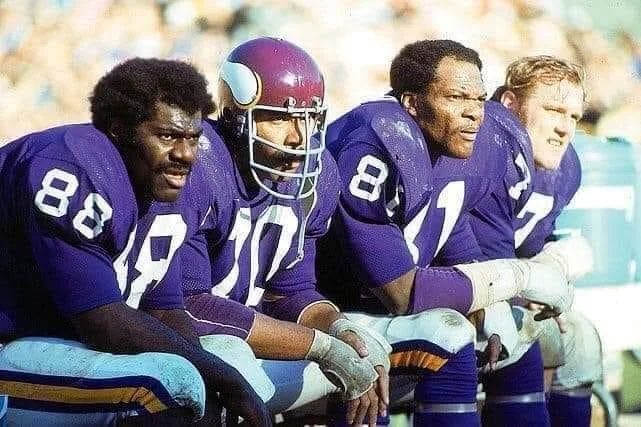
Super Bowl XII: January 15, 1978
This was the first Super Bowl ever played in the Superdome. Actually, it was the first Super Bowl to be played in any Dome. It also happened to be the first time the game was played during primetime in the eastern time zone.
This year, it was All in the Family that featured the game in their show. In an episode called “Superbowl Sunday,” Archie Bunker rented a big screen TV at this bar “Archie’s Place” and sold ham sandwiches for $2. Later, two robbers steal from the bar’s patrons and humiliate them by having them all put down their pants at the end of the game.
On the field, the drama was centered on Craig Morton, the former quarterback of the Dallas Cowboys. He was now playing for the Denver Broncos. Their opponent was the Cowboys, now led by their new QB Roger Staubach. Just like he won the starting job in Dallas, Staubach once again beat Morton (and his Broncos). The score was 27-10.
Super Bowl XV: January 25, 1981
It was just five days after the Iran Hostage Crisis had come to an end, giving the game an especially patriotic feel. The pregame festivities honored the end of the crisis. An 80-foot long and 30-foot wide yellow bow was attached to the outside of the Superdome. Additionally, miniature bows were given to each fan and every player wore a yellow stripe on the back of their helmets. “Mardi Gras Festival” was the halftime show.
This time the main football-related storyline was how one of the competing teams—the Oakland Raiders—would be moving to Los Angeles before the start of the 1982 season. The NFL didn’t want to see one of its historic franchises leave Oakland, but Raiders’ owner Al Davis sued the league and eventually won. The relationship between Davis and NFL Commissioner Pete Rozelle was tense and the media openly wondered if Rozelle would present the Vince Lombardi Trophy to Davis should Oakland triumph in the game over the Philadelphia Eagles.
The Raiders became the first wild card team to win the Super Bowl, and the trophy presentation between Rozelle and Davis was surprisingly (maybe disappointingly) civil.
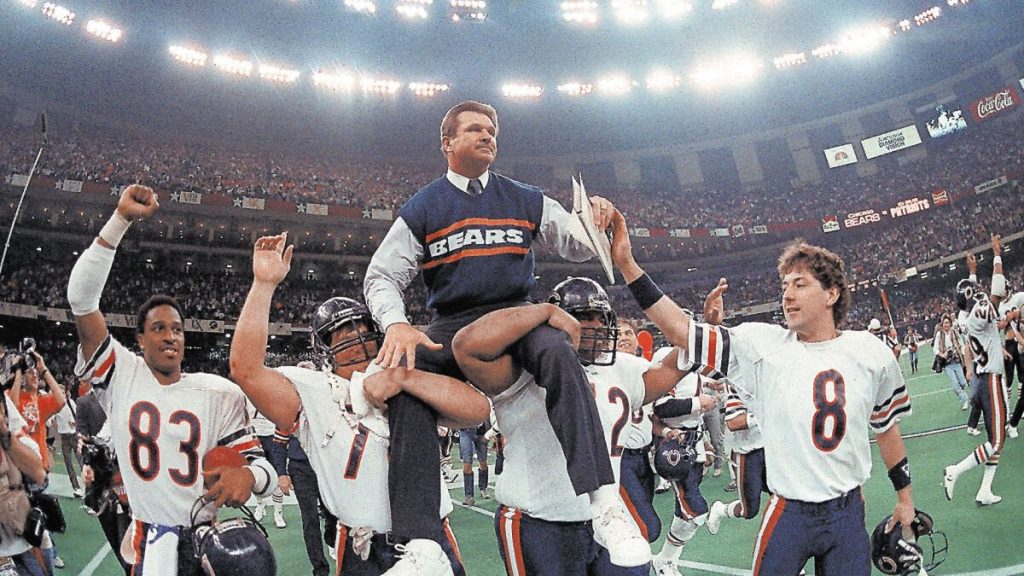
Super Bowl XX: January 26, 1986
In 1986, the Super Bowl was all about “Da’ Bears.” The team had gone 15-1 during the regular season before becoming the only team to shut out both of its playoff opponents. A few weeks earlier, the Bears had recorded the infamous—also hilarious—”Super Bowl Shuffle” rap.
Those Bears were up against the Cinderella story that was the New England Patriots. They eked their way into the playoffs as the second wild card before making it to Super Bowl XX.
But the Patriots’ Cinderella was put to an end by the Bears. Chicago’s vaunted defense sacked New England Quarterback Tony Eason seven times and held the Patriots to a total of only seven rushing yards!
Super Bowl XXIV: January 28, 1990
The next time New Orleans hosted the Super Bowl was an even bigger blow out. In fact, it was the largest margin of victory in the game’s history with Joe Montana’s San Francisco 49ers defeating John Elway’s Denver Broncos 55-10. Montana completed 76% of his passes on his way to his fourth Super Bowl win. The win took Montana’s record at the Superdome to a shocking 8-0 thanks in large part to the 49ers dominance over their then-division rival New Orleans Saints.
The pregame show was a salute to Mardi Gras, and the national anthem was performed by beloved local soul and R&B singer Aaron Neville. The local flair continued into the halftime show which was a tribute to both New Orleans and the 40th anniversary of the comic strip Peanuts.
The halftime show featured performances by three local natives—clarinetist Pete Fountain, fiddle player Doug Kershaw, and singer Irma Thomas. Local college marching bands from Southern University, ULL, and Nicholls State also performed. The finale featured a float decorated as a riverboat several stories high. It was so large the goal posts had to be removed from one end zone.
Super Bowl XXXI: January 26, 1997
This game would mark Brett Favre’s first and only Super Bowl victory. They would go on to defeat the New England Patriots, led by head coach Bill Parcells. Much of the drama leading up to the game was based on a report alleging strife between Parcells and Patriots’ owner Robert Kraft. It was believed Parcells would defect to the New Jersey Jets following the season. (He did, and refused to fly back to Boston with the Patriots following the game.)
Super Bowl technology was advancing, and this was the first broadcast to have a constant, live-updating graphic displaying the score, time, and down and distance.
The pregame show featured the multi-platinum smash hit and dance craze, “Macarena,” by Los del Río. Miss Louisiana 1996 Erika Schwarz Wright performed sign language alongside the national anthem performed by Luther Vandross. And, for the coin toss, the winning head coaches of the previous six New Orleans Super Bowls were featured. New Orleans had cemented itself as a staple of the Super Bowl.
Super Bowl XXXVI: February 3, 2002
Following the attacks of September 11, 2001, the NFL postponed a week of regular season games. As a result, the rest of the season—Super Bowl included—was pushed back a week, making this the first Super Bowl played in the month of February.

Patriotism and spectacle rang through the entire event with Mariah Carey and the Boston Pops performing the National Anthem, George H.W. Bush becoming the first president (past or present) to participate in a Super Bowl coin toss, and U2 performing a three-song set at halftime. During their hit song, “Where the Streets Have No Name,” U2’s lead singer, Bono, replaced the lyrics “take shelter from the poison rain” with “dance in the Louisiana rain” to loud cheering. At the conclusion of their performance, Bono opened his jacket to reveal an American flag printed into the lining. In 2013, Sports Illustrated ranked it as the best halftime show in Super Bowl history.
The St. Louis Rams entered the game as a whopping 14-point favorite, but three touchdowns prevented the team from scoring a touchdown until the fourth quarter. With the game tied 17-17, the Patriots marched down the field, led by a young Tom Brady, with less than one minute and 30 seconds remaining. In the final seconds of the game, the Patriots kicked a field goal, making it the first time a team won the Super Bowl on the game’s final play.
Super Bowl XLVII: February 3, 2013
For the first time in Super Bowl history, the game featured two brothers—Jim and John Harbaugh—coaching against one another. Before the game, it was nicknamed the Har-Bowl.
The Baltimore Ravens got off to a strong start, taking a first half lead of 21-6.
Beyonce headlined the halftime show, bringing back the other members of Destiny’s Child for a surprise performance.
But, unfortunately Super Bowl XLVII will also be remembered for what took place after halftime. The Ravens returned the opening kickoff for a record 108-yard touchdown, increasing their lead over the 49ers to 28-6. But then, the Superdome’s power partially failed. The power outage stopped play for 34 minutes, earning this Super Bowl another nickname: the Blackout Bowl.

After the lights returned and play resumed, the 49ers roared back to as close as 31-29. In the end, the Ravens held on and closed out the game for a 34-31 victory, with big brother John defeating his baby brother Jim.
Super Bowl LIX: February 9, 2025
After a 12-year hiatus, the Super Bowl is back in New Orleans. We’re excited to build more great football memories as the Philadelphia Eagles take on the Kansas City Chiefs in the 59th iteration of the big game.
The post From blackouts to blowouts and nail-biters to Purple People Eaters, New Orleans’ 10 previous Super Bowls have been full of memories appeared first on Gambinos Bakery.
Hot air balloon crashes, battle reenactments, and a trash-talking newspaper editor made New Orleans’ first Super Bowl a wild affair! 28 Jan 2025, 5:57 pm
Super Bowl LIX is just two weeks away! Those of us in and around New Orleans are excited to be hosting the biggest game in sports for a record-setting 11th NFL championship game—tied only with Miami.
But, before we focus on New Orleans’ 11th time hosting, we wanted to roll back the clock and remember our first. It was Super Bowl IV, held 55 years ago on January 11, 1970.
A battle between two separate, rival leagues
Something that was interesting about the fourth iteration of the Super Bowl is that it was the first time the game was actually branded as the “Super Bowl” rather than the three previous years being billed as the “AFL-NFL World Championship game.”
Back then the game was played by teams from two completely separate leagues—think of the NFL of today playing against, for example, the Canadian Football League.
For the first four Super Bowls, it was the champion of the American Football League (AFL), founded in 1960, against the winner of the NFL (National Football League), founded in 1920. The rivalry between these leagues was bitter, though the NFL was largely considered to be more talented. In the first two Super Bowls, the NFL’s Green Bay Packers pummeled their AFL opponents.
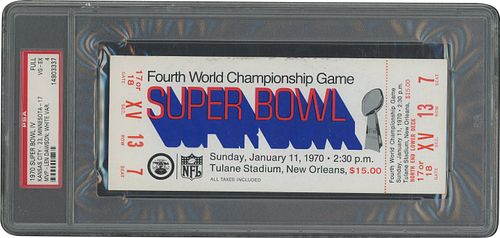
In Super Bowl III, however, Joe Namath of the underdog New York Jets guaranteed his AFL team would defeat the NFL’s Baltimore Colts. Even though the Colts were favored by a mind-blowing 18 points to defeat Namath’s team, the Jets won the game, creating a bit more of a feeling of parity between the leagues.
Super Bowl IV was set to take place at Tulane Stadium—the Superdome wouldn’t open for four more years—and the AFL team (the Kansas City Chiefs) was once again a big underdog (13.5 points) to the NFL’s Minnesota Vikings.
The rivalry was at an all-time high as the NFL wanted to avenge their loss of the previous year.
New Orleans’ last Super Bowl would actually be the final time that football’s biggest game was played between two rival leagues. The following season, the two leagues had merged. The teams had integrated into what is now the American Football Conference (AFC) and the National Football Conference (NFC)—two conferences in one National Football League.
Rivalry between cities
The meeting to determine which city would host Super Bowl IV took place on March 19, 1969 in Palm Springs, California. At the time, the Super Bowl was thought of as a regional event. West Coast fans could attend the game in Los Angeles, the site of Super Bowl I, while East Coast fans would go to Miami, host of II and III.
Miami was considered the favorite to host Super Bowl IV, as well, but New Orleans was not ready to accept such a limited view of this growing championship event.
The meeting to decide the site included 26 league owners. The Crescent City sent a task force led by executive editor of the Times-Picayune, George Healy. Almost immediately, the group from New Orleans turned on both trash talk and charm.
Healy was reprimanded for continuously interrupting Miami mayor Steve Clark’s presentation. The Times-Picayune editor mocked the low attendance at Dolphins regular season games and went so far as to question whether the city of Miami was even interested in football.
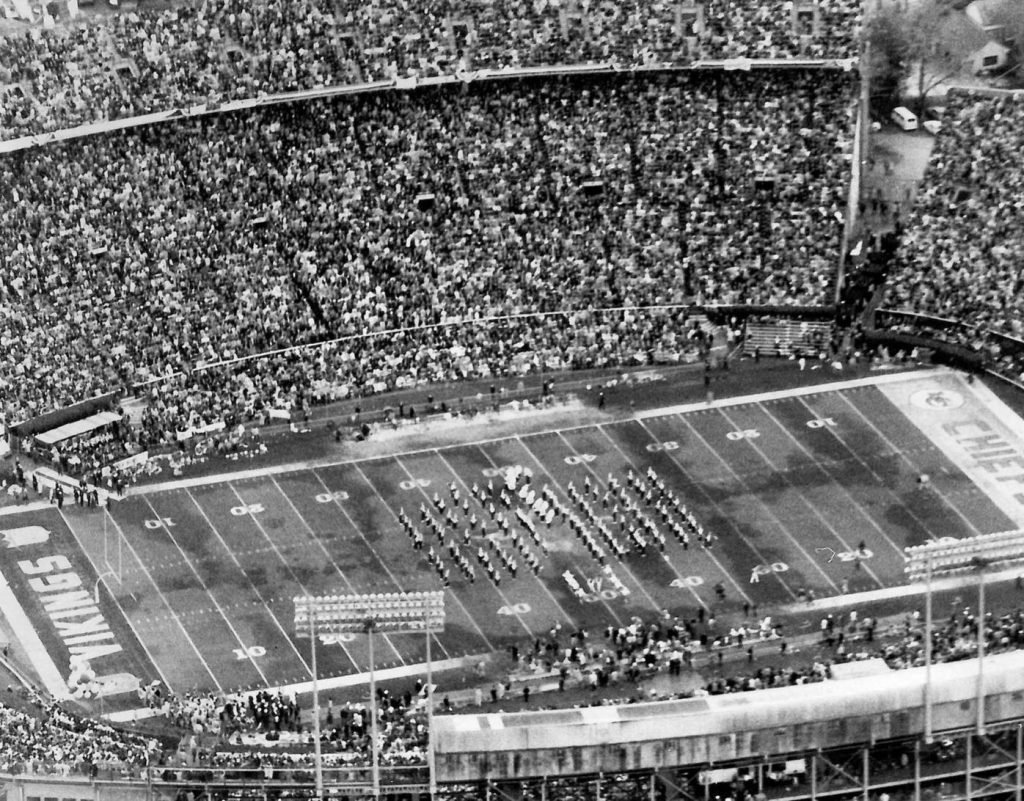
Meanwhile, Healy brought jazz trumpeter Al Hirt and composer Hoagy Carmichal, both from New Orleans, to entertain football team owners at a party the night before the vote. Hirt told them he had three loves, “my horn, my team [the Saints], and my hometown,” even promising them a free halftime show should New Orleans win the bid.
In the end, NFL commissioner Pete Rozelle considered the size of Tulane’s 80,985-seat stadium, the growing interest of football in New Orleans, and the desire to move the Super Bowl back to an NFL—instead of AFL—host city.
In what was thought of as a total coup at the time, New Orleans won the rights to host Super Bowl IV!
Cold weather, but hot entertainment
Something we’re all familiar with lately—uncharacteristically cold weather—descended on New Orleans the week before the game. The temperatures were so low that, by the time the teams arrived six days before the Super Bowl, the outdoor fountain at the Kansas City Chiefs’ downtown hotel had completely frozen over.
Adding a further chill on the lead-up to the event, NBC News reported that Chiefs starting quarterback Len Dawson was tied to a national gambling ring.
As the game neared, however, ice and tensions began to thaw. Temperature warmed and Dawson’s insistence he was innocent eventually led to federal authorities absolving him.
Then in came the celebrities. Bob Hope, Frank Sinatra, Walter Cronkite, Gene Autry, and moon-landing astronauts Neil Armstrong and Buzz Aldrin all descended on the Big Easy for Super Bowl week.
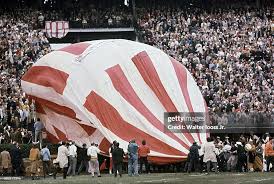
The city was under a tornado warning on Super Bowl morning, and groundskeepers laid green-painted pecan shells and hay across the field to mitigate the damp playing surface. But, by 2:30pm kick-off, the temperature was up to 61 degrees and 80,562 fans (the most at a Super Bowl to date) packed the stadium.
The pregame show dazzled the crowd with the release of 3,000 pigeons and a jet flyover during a special rendition of the national anthem. A hot-air balloon carrying a Minnesota Vikings mascot wasn’t so effective. It failed to gain altitude, dragged across the field, and crashed directly into the stands. No one was injured, fortunately, but the game was delayed by about 10 minutes.
Halftime went smoother, and was far more extravagant than the Super Bowl had seen to date. Opera soprano Marguerite Piazza and Broadway star Carol Channing were the first real celebrity performers at a Super Bowl, kicking off one of America’s favorite sports traditions. During the same show, trumpeters Al Hirt and Doc Severinsen, along with the Southern University marching band, performed a musical tribute to New Orleans.
The musical performance, which honored New Orleans’ most famous streets then gave way to canons, muskets, and military uniforms during a reenactment of the Battle of New Orleans. The show concluded with a parade of southern ladies, a rendition of “Do You Know What It Means to Miss New Orleans?” and a snapshot of a Mardi Gras parade featuring floats, inflatables, maskers, and brass bands.
Game time
The Battle of New Orleans was a faithful recreation, but the real firepower that day was demonstrated by the Kansas City Chiefs offense.
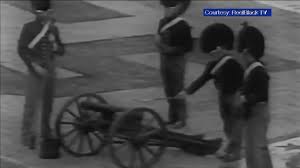
The game was a matchup between two very different styles of play. The Vikings had won 12 straight regular season games before steamrolling through the NFL playoffs. They were known for a fearsome defense, led by their dominant Purple People Eater defensive line, that could wreak havoc on an opposing quarterback. On offense, they controlled games and tired their rivals by incessantly running the ball.
The Vikings played what was considered an old-school style of dominant football compared to the Chiefs. Kansas City was nearly the opposite, described as cutting edge both on and off the field. That began with recruitment. They were one of the first pro teams to look to Historically Black Colleges and Universities (HBCUs) for talent and their team featured 13 players from such schools including superstar Ots Taylor and Hall-of-Famer Buck Buchanan.
On the gridiron, the Chiefs were equally innovative. Their offense attack was diverse, utilizing shifts, motions, formations, and alignments. They used short, quick passes to neutralize the Vikings vaunted defensive line before they could reach the quarterback. Their defense was equally superb and was ranked the seventh best in football history according to a 2007 ESPN poll.
The Chiefs jumped out to an impressive 16-0 lead after the first half, and won the game 23-7.
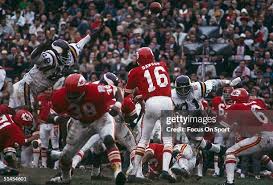
Super Bowl IV was considered a huge win, not just for the Chiefs, but also for the city of New Orleans and the sport of football. In addition to the more than 80,500 fans in the seats, the game took in a record $3,817,872.69 in gross receipts. It was estimated that 60 million viewers watched the CBS broadcast of the game.
It was such a success that New Orleans was awarded another Super Bowl just years later. Super Bowl VI would be the city’s second. We’ll write about that game—and the eight other Super Bowls hosted in the Crescent City since—next week!
The post Hot air balloon crashes, battle reenactments, and a trash-talking newspaper editor made New Orleans’ first Super Bowl a wild affair! appeared first on Gambinos Bakery.
Did you know king cake used to be a one-day-a-year treat? 6 Jan 2025, 5:08 pm
Everyone in our slice of Louisiana is fully aware that king cake season begins on January 6. It’s the beginning of Carnival season, which means our favorite purple, green, and gold treat is available all the way until Mardi Gras.
But what many people — and we’d wager to say most people — don’t realize is that for many years, king cake season not only began on January 6, but it was only January 6. In fact, it was more of a Christmastime treat than a Carnival season one.
So how did New Orleans’ favorite Mardi Gras sweet rise to its current place in our cultural zeitgeist? It all began in Ancient Rome.
Origins of a cake
The king cake tradition began 4,000 years ago in ancient Rome. The cake was eaten during Rome’s biggest festival of the year: Saturnalia. During this celebration that could last as long as two weeks, partygoers ate too much, drank too much, and dressed up in colorful costumes. Sounds a little like Mardi Gras, right?
Even the tradition of their cake is similar to ours. There was an object hidden inside. Though instead of a plastic baby, it was a fava bean. Whoever received the slice of cake with the bean was crowned queen or king of the Saturnalia and was treated like royalty. Except, in the earliest years of Rome, at the completion of Saturnalia the faux royalty was sacrificed — AKA killed — as a gift to the gods. (So next time you get the slice with the baby and complain about having to buy the next king cake, remember…it could be much worse!)
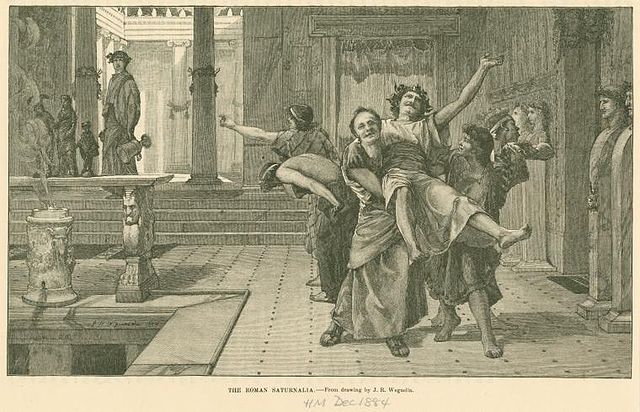
But when was Saturnalia celebrated? Around the same time that we celebrate Mardi Gras?
Nope! The Saturnalia was a festival celebrating the Winter Solstice. In the northern hemisphere, that’s December 21, the longest night of the year. This means every day after the solstice, the sun rises a little higher in the sky and the days last a little longer. The darkest days were behind and Spring, with all its warmth and bounty, was coming. That is definitely worth celebrating.
The Roman predecessor to king cake was eaten around the Winter Solstice — in December — rather than during Carnival season…which, unfortunately for the Romans, didn’t exist yet.
So how did we make the shift from December 21 to January 6? That one is thanks to Christianity.
Those Three Kings
To this day, versions of king cake exist all over Europe and the Americas. The reason is that as Rome expanded to become the Roman Empire, they brought their traditions with them. From the island of Britain in the west, to Greece and Cyprus in the east, families adopted the custom of hiding something that signified good fortune inside their winter cake. Whoever found that something was crowned faux royalty.
As Christianity swept across the continent to various nations and kingdoms, they incorporated some of pagan Roman traditions into their own — sometimes by adding their own symbolism to make those pagan customs feel more Christian. For example, the Saturnalia cake became “Three Kings cake” — named after the Three Kings who were believed to have presented their gifts to the baby Jesus on January 6.
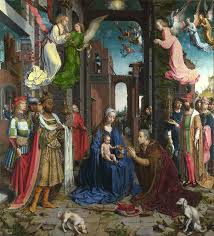
The Spanish still eat Roscón de Reyes and the French enjoy Galette des Rois and Gâteau des Rois. Germans and Swiss eat Dreikönigskuchen, while the Portuguese celebrate with Bolo-Rei. These are all descendents from the Roman version of the cake, and there are many other versions across Europe, as well.
Each of these cakes look somewhat different and have distinct-sounding names. But they have a lot of similarities, too. One is that many of the cakes are eaten on or around January 6 in honor of those Three Kings.
That was certainly true in France. And when the French created a colony centered in New Orleans, they brought their Gâteau des Rois (translated to “cake of kings”) tradition with them.
King cake in a new world
January 6 wasn’t only a day to celebrate the Three Kings. It also marked the end of the Christmas season, known as Christmastide.
Perhaps you are familiar with the holiday song, The Twelve Days of Christmas? Well, the Twelfth Day of Christmas is January 6. (Counting from Christmas Eve.) The sixth day of January, then, is often called “Three King’s Day,” “King’s Day,” or “Twelfth Night.”
When the first Creole New Orleanians in the 18th century would eat their French version of the “Three King’s cake,” they would only eat it on January 6.
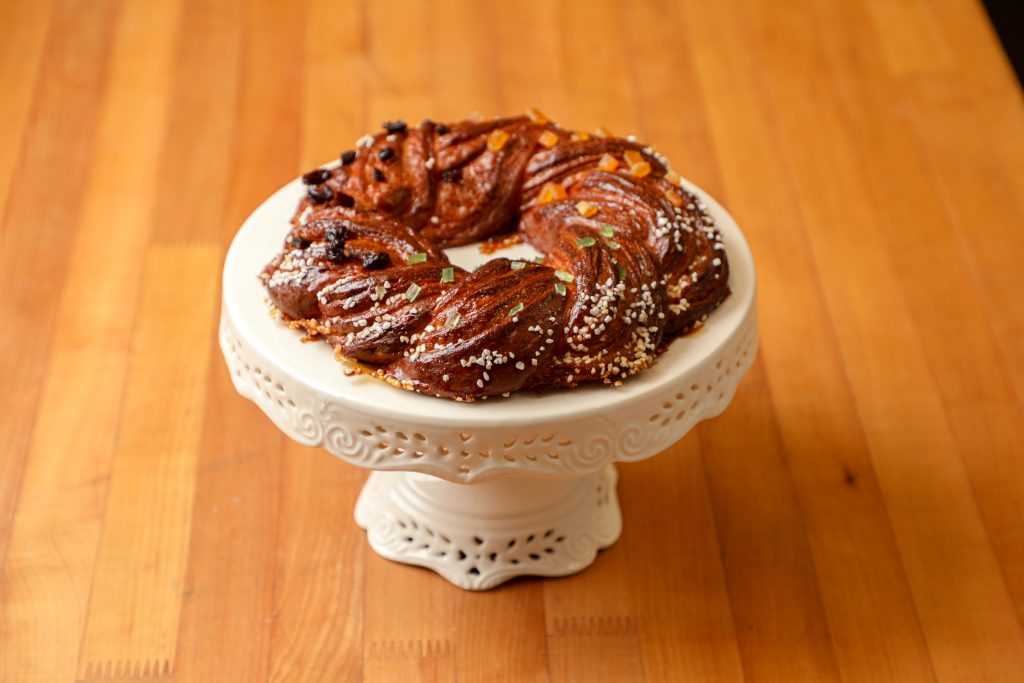
That’s how things went for the remainder of the 1700s and even well into the 1800s. Three King’s cake became King’s cake, which eventually became king cake. Still, it was a one day affair. If you got the bean — or, some believe in Louisiana that the fava bean was replaced by a pecan — then you were responsible for next year’s party and cake.
If you think one year is a very long time to wait for such a fun and delicious tradition, the Anglo-New Orleanians agreed with you.
Those Anglo-New Orleanians only began encountering king cake in the latter half of the 19th century thanks to Carnival krewes. In the 1870s, some of those early krewes would have their start-of-the-season ball on Twelfth Night. If you’re going to have a ball, you’ll have a cake. And if you’re going to have a cake on Twelfth Night, someone had the bright idea that it should be a king cake.
For a large chunk of New Orleanians — specifically the ones that were not Creole — this was their introduction to king cake. And you know what? They loved it!
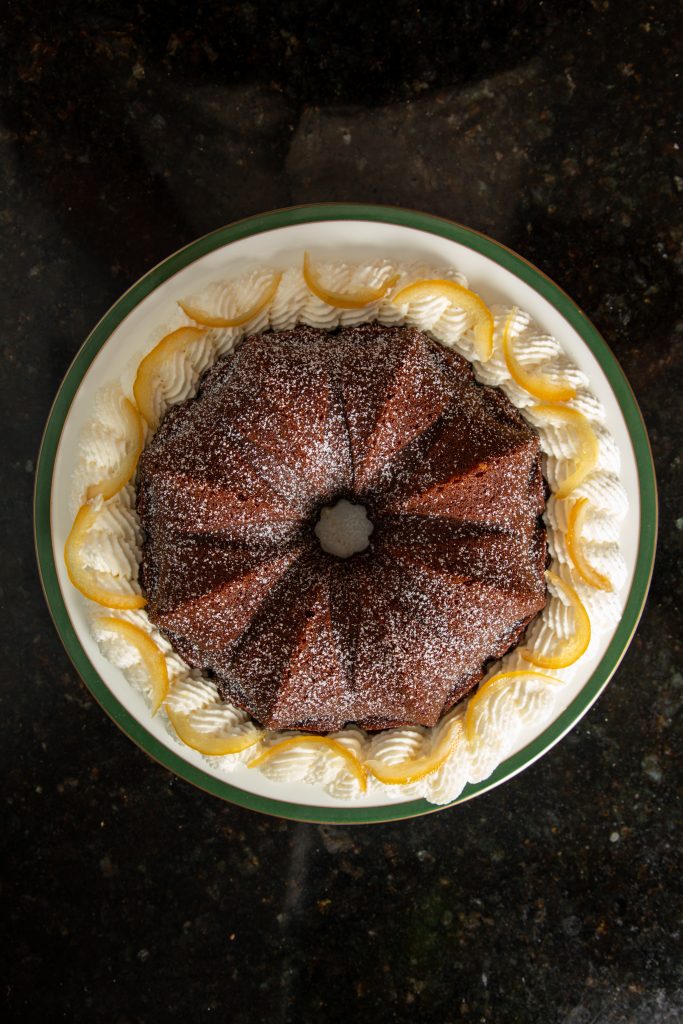
As the late-19th century turned into the 20th century, some of those Anglo-New Orleanians had an interesting idea. Rather than waiting an entire year, they said that whoever found the pecan, bean, or baby in the king cake should host a party the next week with more king cake. The same thing would happen the next week. And the week after. Suddenly our Christmas king cake was elbowing itself well into Carnival season.
By the 1940s, thanks in large part to McKenzie’s Bakery, it was common to see those king cakes decorated with purple, green, and gold sugar. (Though the first example of the Carnival-colored king cake was reported back at the turn of the century.)
King cake in New Orleans had officially become a Mardi Gras tradition. And we’re not complaining. We much prefer baking and eating it over an entire season, rather than on just one single day.
The post Did you know king cake used to be a one-day-a-year treat? appeared first on Gambinos Bakery.
Our community supports us, and Gambino’s loves supporting it back 6 Dec 2024, 8:06 pm
For decades, our community has given Gambino’s Bakery so much support. We love being able to give back to the community as much as possible.
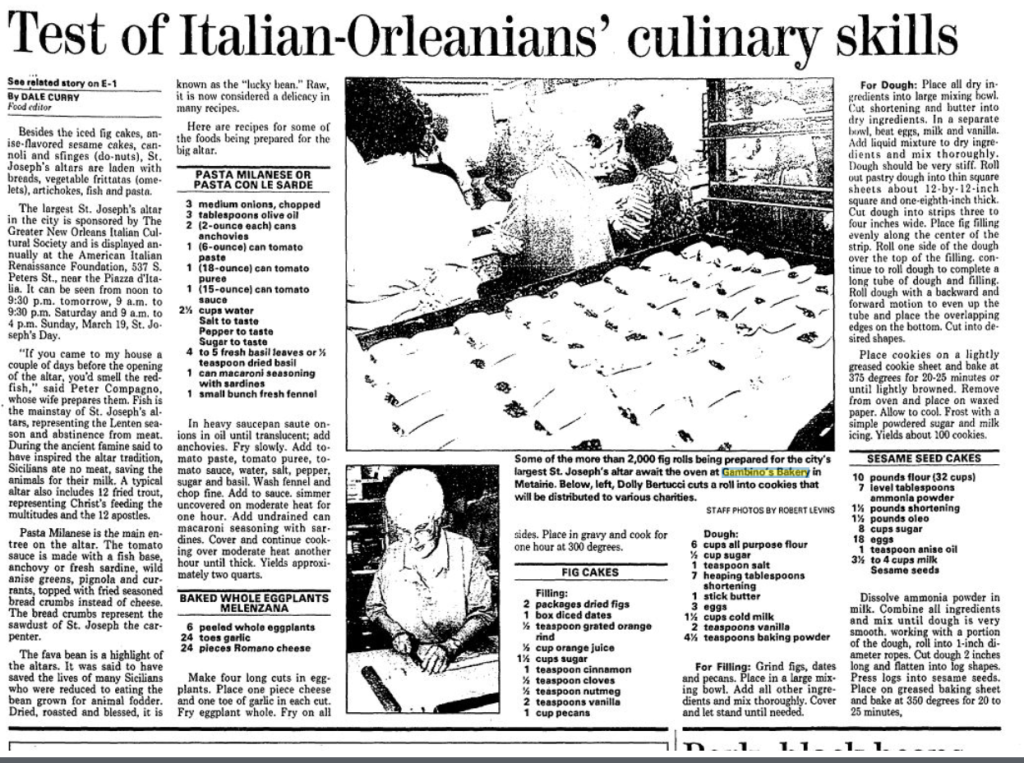
Our community has always been a top priority at Gambino’s Bakery. Yes, of course that means baking the best pastries, cookies, and cakes possible to help make our customers’ special moments a little more memorable. But it also means serving the people of Louisiana and supporting the causes we care most about.
“These are our neighbors,” said Sam Scelfo, whose family has owned Gambino’s Bakery for more than four decades. “We are a part of the communities we serve, and so if we have an opportunity to make our community better in some way, we are going to do it.”
Looking through old newspaper articles, we were proud to find many-dozens of examples of philanthropy by our bakery’s leadership over the past 75 years. Even before the Scelfo’s took charge.
Supporting our neighbors with physical handicaps and health challenges has always been important to us. This blog post about our work with Bryan Thomas, the boy with a “bad heart” is just one example.
We also found this article in the April 5, 1973 edition of the Times-Picayune about how the State of Louisiana was honoring five businesses for their work hiring and training handicapped employees. One paragraph read as follows:
“Five businesses were recognized by the Division of Vocational Rehabilitation of the State Department of Education as affording the handicapped an opportunity to prove ability counts.”
Gambino’s Bakery, along with Perrin’s House of Seafood in Marrero, Grants Store in Chalmette, St. Joseph and Mary Residences for the Elderly in New Orleans, and Anthony Abraham Builders in Marrero were all honored for their dedication to working with employees with some form of physical disability.
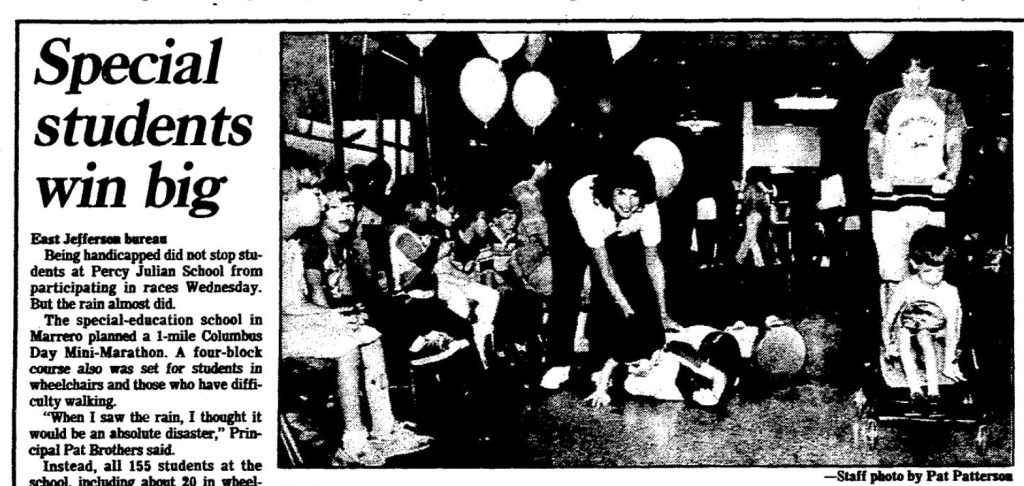
There are also tons of examples of times where we donated cakes and other refreshments for events for these types of organizations. For example, we’ve proudly donated our products to the March of Dimes famous walk on numerous occasions.
Another example, from October of 1983, came when a special education school on the West Bank named “Percy Julian School” organized a one-mile “mini marathon” for its students. The event brought together all 155 of the school’s students, including about 20 in wheelchairs, alongside parents, school staff, and University of New Orleans faculty members. We were there, too, providing a cake for post-race festivities.
“It’s superb exercise for our students,” principal Pat Brothers explained to the Times-Picayune. She said the idea of the event was to show special education students and their families that exercising such as jogging or walking was possible for them.
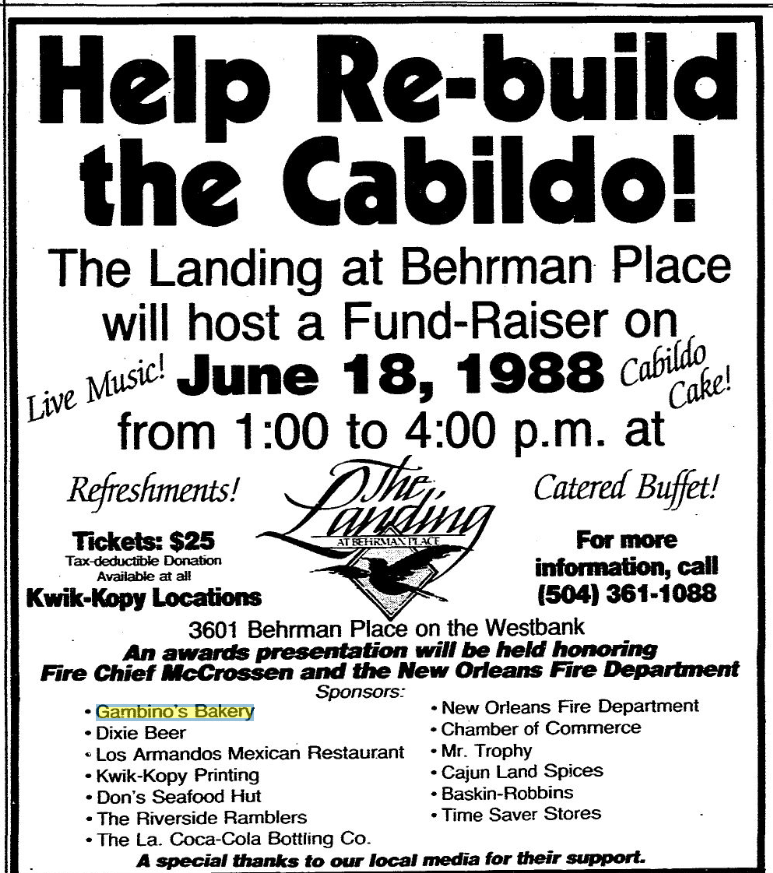
Over the years, we’ve taken part in a variety of causes in which we believed.
When the Cabildo in Jackson Square was damaged by a devastating fire in 1988 due to a wire caused by a welder’s torch, we were there to support the rehabilitation effort — both as a fundraising event sponsor and as the bakers of a Cabildo replica cake! When the Society of St. Vincent de Paul wanted to provide Christmas gifts to 400 needy children in Baton Rouge, we were there, too. And when the Bloom ‘N Art gala sought to support the Hospice Foundation of Greater Baton Rouge, we were thrilled to provide dessert. From children to education and art to cultural cornerstones, we jump at the opportunity to back our state’s great causes.
One of our favorites is providing baking space to the New Orleanians that create many of the beautiful St. Joseph’s Day altars each March. The elaborate displays are filled with cakes, cookies, pasta, breads, and more. The more intricate the altar, the more necessary it is to find a cooking space.

For years, we partnered with the Greater New Orleans Italian Cultural Society on their altar. In 1995, for example, dozens of women came to our kitchen to make more than 2,000 fig rolls to be placed on the region’s largest St. Joseph’s Day display.
It’s a cause that is near and dear to our heart, like so many others. In a future article we’ll talk about another one of our other favorites, the wildly popular Italian Open golf tournament. Gambino’s had close ties to the tournament helping to raise quite a bit for charity.
“We’ve always been proud to support the causes that are meaningful to us and to our city and state,” Scelfo said. “That’s not going to stop anytime soon.”
The post Our community supports us, and Gambino’s loves supporting it back appeared first on Gambinos Bakery.
Gambino’s Connection to Tulane University Sports 15 Oct 2024, 7:50 pm
At Gambino’s, we’re proud of our bonds with the community. For years that connection has been extra strong when it comes to Green Wave athletics at Tulane University!
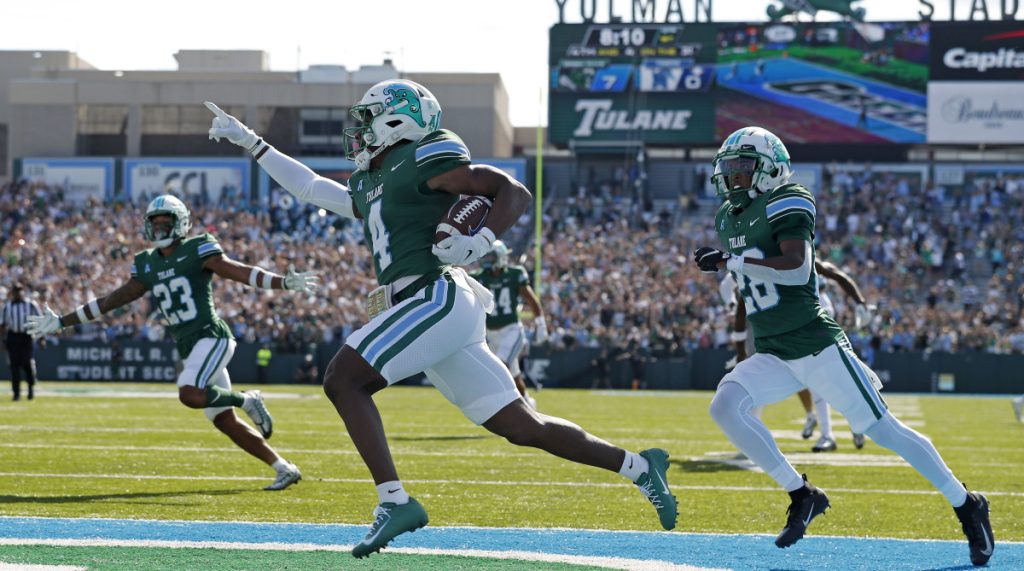
Gambino’s Bakery is proud to be a business steeped in the greater New Orleans community.
Over our 75 years, we’ve developed close ties with many of the institutions that make our city special. Perhaps none of those ties is longer-lasting than our connection to Tulane University Athletics.
One early link was due to the sporting prowess of former Gambino’s owner, Sam Scelfo, who was a defensive lineman for the Green Wave football team from 1967 – 1970. His tenure included an impressive 17-3 drubbing of the Colorado Buffaloes in the Liberty Bowl in Memphis, Tennessee. That was the final game of his final season.
Fourteen years later, Scelfo was leading Gambino’s Bakery. He took over in 1976 and it didn’t take long for him to hire Ralph Pedersen, Tulane University’s head basketball coach of seven seasons during the 1960s and ‘70s.
At Gambino’s Pedersen was responsible for our frozen foods division — at the time that included items like cornbread, garlic bread, and biscuits — helping to grow Gambino’s distribution from Louisiana-only in 1983, to 22 states six years later.
But back when Pedersen was at the helm of Tulane’s basketball team, SEC programs were seriously underfunded. They simply were unable to compete with other powerhouses. As a result, Pedersen’s seven-year record was a lamentable-sounding 68 wins and 104 losses, but due to the limited resources he had to work with, it’s an impressive feat that those 68 wins makes him the eight winningest coach in Tulane basketball history.
In a 1989 feature in the Times-Picayune, the former skipper kept a sense of humor about the challenges his teams faced on the court, and the twists and turns his career has taken since then.
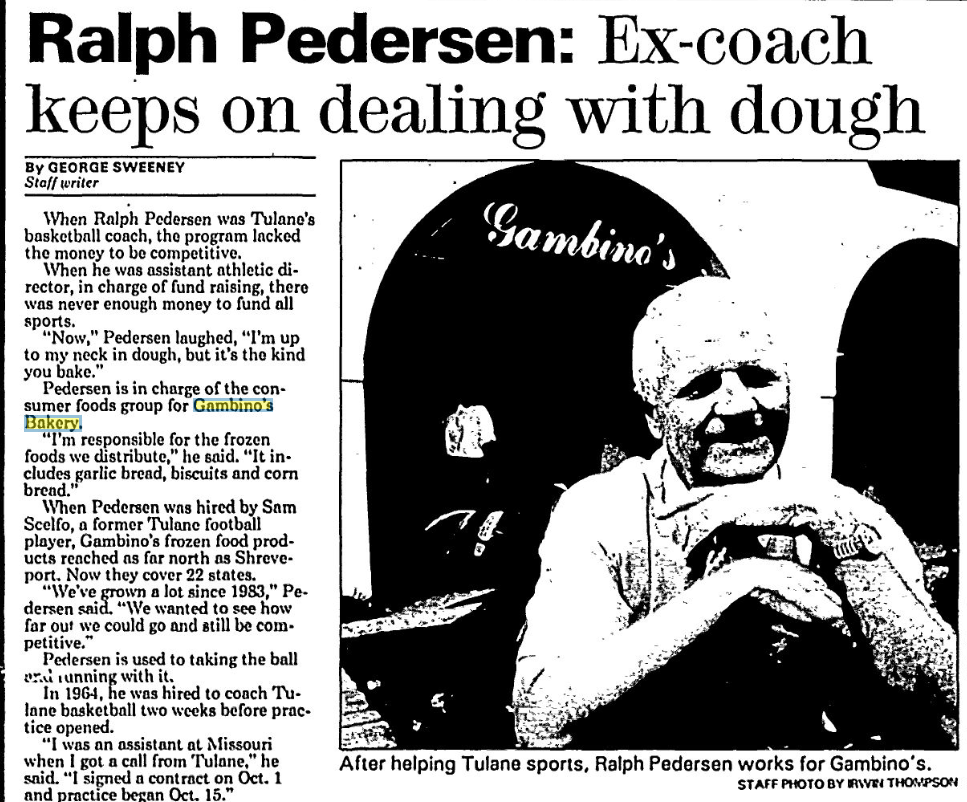
The article began: “When Ralph Pedersen was Tulane’s basketball coach, the program lacked the money to be competitive.”
“Now,” Pedersen joked with the reporter, “I’m up to my neck in dough, but it’s the kind you bake.”
It was a fun write-up for Gambino’s and the former coach. Pedersen told the reporter one more story — this one from his coaching days — that we thought was hilarious.
He recalled a game against West Coast powerhouse UCLA. He said it was his most memorable loss given how vaunted the visiting Bruins team was at the time. Not a single person expected Tulane to win, but when the Bruins came down the court on their first possession, they missed their first shot.
In contrast, Tulane grabbed the rebound and hit our first shot. Unexpectedly, the Green Wave was up 2-0.
The crowd was excited and the early lead — no matter how small — was welcomed. Still, players and coach knew it was unlikely they were going to maintain that lead against an historically dominant team like UCLA.
Pedersen recalled the scene years later for the Times-Picayune: “I remember [Tulane guard] Terry Habig running past our bench with his fist held high and yelling, ‘We got ‘em now!’ The next time I looked up, it was 14-2 UCLA.”
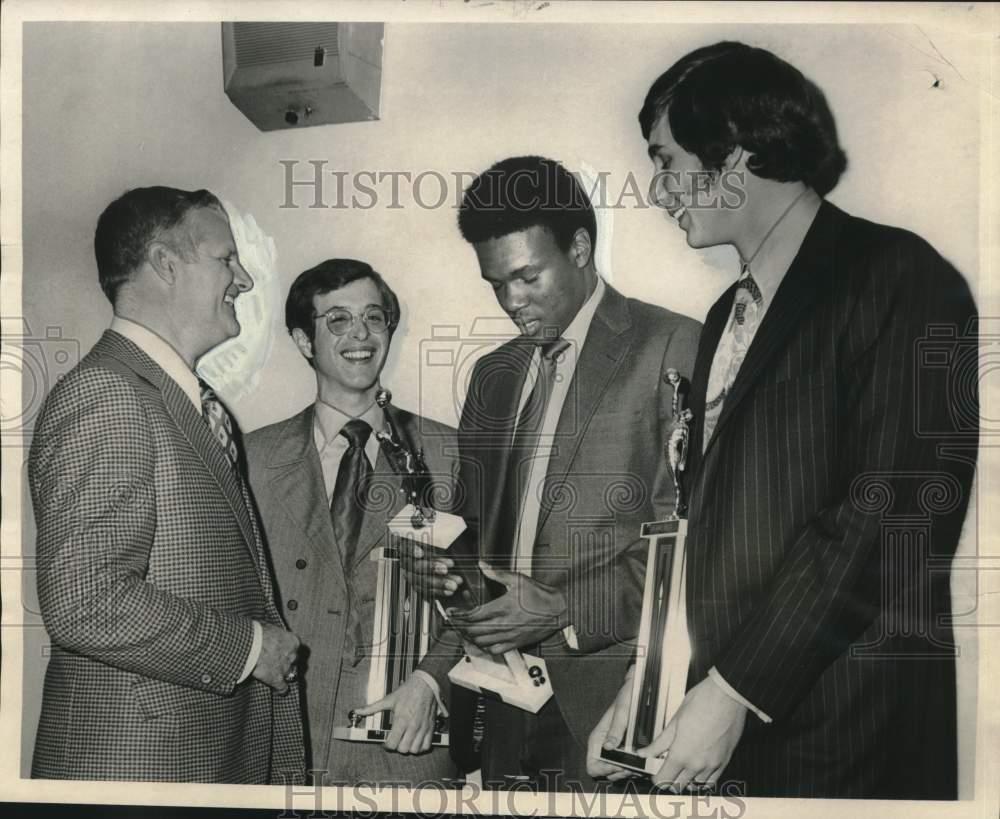
Familial ties with Green Wave football
Basketball wasn’t the only Tulane team with which Gambino’s had close ties.
In 1998, the New Orleans university’s football team was a perfect 11-0. But, before playing in the Liberty Bowl at the end of the year, head coach Tommy Bowden was hired away by Clemson University.
That left Tulane in the unenviable position of searching for a new head coach before the final game of their season.
In comes Chris Scelfo, assistant head coach of the University of Georgia — and also brother of Gambino’s owner Sam Scelfo!
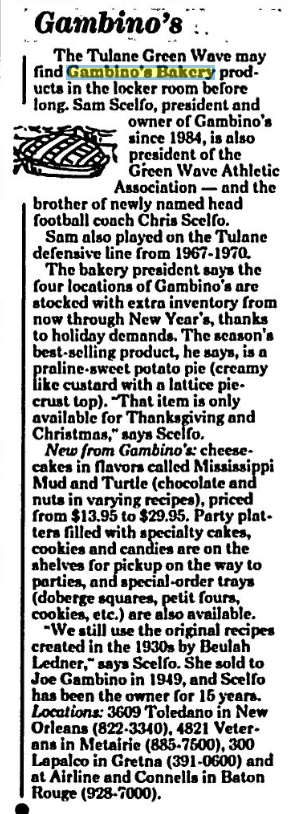
Like his brother, Chris was a football player at ULM — even earning the honor of being named team captain.
And while stepping into supporting coaching positions at the University of Oklahoma, Marshall University, and UGA, the head coaching job at Tulane would be Chris’ first experience as boss.
Fortunately, his head coaching career got off to a promising start. On New Year’s Eve, in 1998, Scelfo led his new team onto the Memphis field at the Liberty Bowl, defeating Brigham Young University to finish an undefeated season!
In 2002, Scelfo led the Green Wave to another Bowl victory — this time winning the Hawaii Bowl against the University of Hawaii Warriors!
Those Bowl-winning seasons were unfortunately the only two winning seasons during Coach Scelfo’s tenure. However, in addition to those victories, he is known for his ability to hold his team together during an unprecedentedly difficult 2005. Hurricane Katrina devastated New Orleans just before the college football season was set to begin and the team was forced to play all 11 of their games on the road. Each game was played in a different city and, although the team only amassed a 2-9 record, players and coach were inspiring in the way they stuck together during a traumatic few months.

Louisiana is no stranger to struggling sports teams from time to time, of course. (See: “The New Orleans Aints,” for example.) And local newspapers are particularly skilled at making light of these struggles.
In a 1999 article highlighting a series of jokes, the writer asked, “Where does the Scelfo family make cream puffs?”
The answer?
“Gambino’s Bakery and the Tulane football program.”
Ouch! Okay, okay — take it easy!
It’s not the only joke related to local football teams that featured our bakery.
After losing eight fumbles early in the 2007 high school football season, Hahnville High School’s legendary coach Lou Valdin quipped to a Times-Picayune sports reporter, “We make more turnovers than Gambino’s Bakery!”
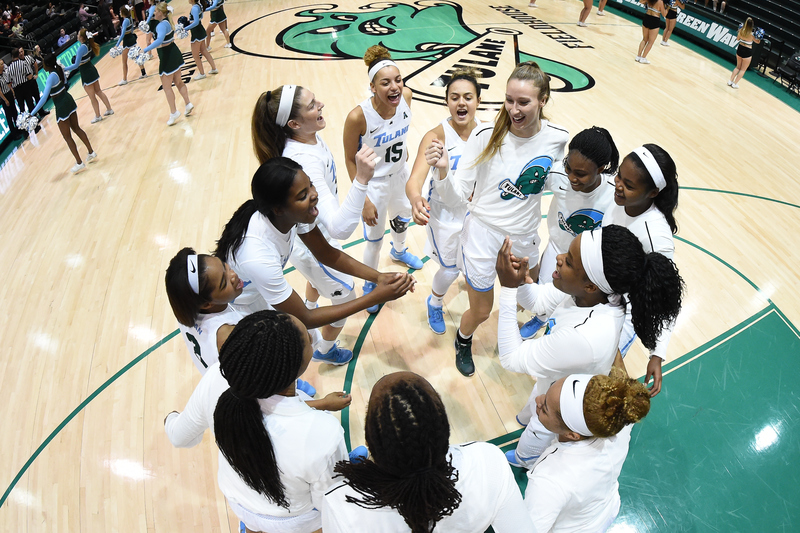
Of course, Valdin would solve his team’s turnover woes, and Tulane University’s football team is hardly a program of cream puffs anymore. Nowadays the Green Wave is often a nationally ranked Top 25 team, regularly featuring in Bowl games. They even won an American Athletic Conference championship in 2022 on their way to a Cotton Bowl victory.
This year — like every year — we’re excited to cheer on our local college football team, as well as all our Tulane athletics squads in what we hope will be another exciting year of New Orleans sports!
The post Gambino’s Connection to Tulane University Sports appeared first on Gambinos Bakery.
When a Gambino’s Birthday Cake Made it to Hollywood 10 Sep 2024, 6:32 am
Hollywood superstar Gregory Peck was in New Orleans speaking at a meeting of the American Cancer Society. It also happened to be his 50th birthday — and what better way to celebrate than with a Gambino’s cake?
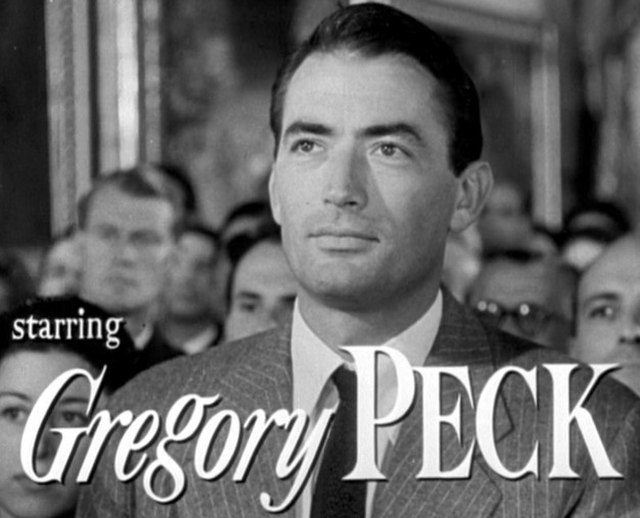
In our 75 years baking for the Greater New Orleans area, we at Gambino’s have had the honor of serving some very important people. Providing sweets to politicians, athletes, and — of course — the families in the communities we serve all give us immense pride.
Occasionally, our confections even find their way into the hands of Hollywood celebrities.
Perhaps none of our brush ups with stardom were more memorable than when, in 1966, we were asked to bake a birthday cake for Hollywood icon, Gregory Peck.
But this wasn’t just any celebration for the Academy Award winner. Peck was in New Orleans on April 5 of that year. He was here to deliver a speech to the American Cancer Society, and also to celebrate his 50th birthday!
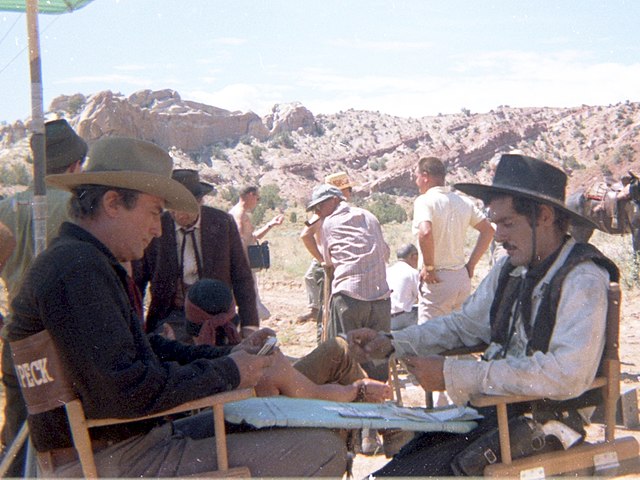
The Legend
No matter your line of work and list of accomplishments, few days in life require a special cake more than a 50th birthday celebration.
Of course, if you’re Gregory Peck, your celebration might be a littler flashier than what the rest of us get.
For those of you who don’t know — Peck is no run-of-the-mill actor. He was nominated for five Academy Awards before finally winning Best Actor in 1962 for his performance in To Kill a Mockingbird as Atticus Finch, the small-town Southern lawyer who defied public sentiment to defend a black man accused of rape.
In 2003, the same year Peck passed away, an American Film Institute (AFI) ranking listed the actor’s Atticus Finch as the top hero in film history.
In another AFI poll — this one from 1999 — Peck was named Hollywood’s 12th-greatest male star of all-time!
He was at the top of his game between the 1940s and 1970s, and acted all the way through the end of the century. From his film debut in 1944, he was a star, though his roles were quite varied: he portrayed a priest in “Keys of the Kingdom,” a romantic in “Roman Holiday,” westerners in “The Gunfighter” and “Yellow Sky,” and combat heroes in “Pork Chop Hill” and “Twelve O’Clock High.” Due to his legendary presence, he often won important and memorable roles such as King David in “David and Bathsheba,” sea captains in “Moby Dick” and “Captain Horatio Hornblower,” the famous general in “MacArthur,” F. Scott Fitzgerald in “Beloved Infidel,” and even President Abraham Lincoln in the TV miniseries “The Blue and the Grey.”
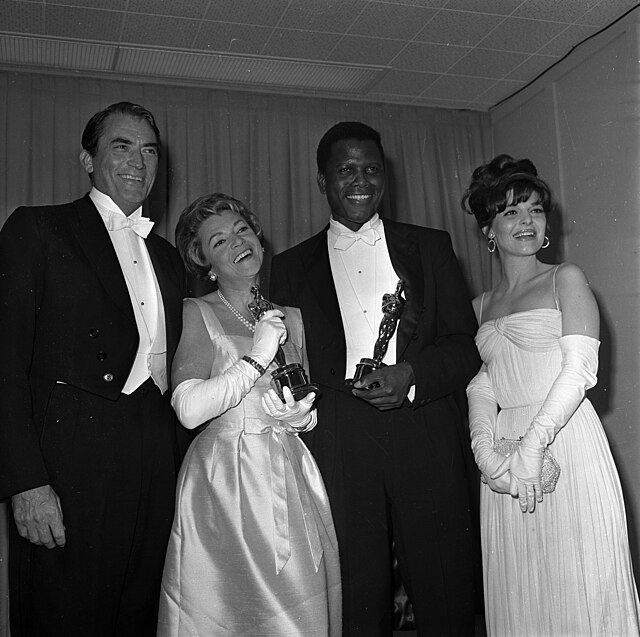
Peck won a lifetime achievement award from the Screen Actors Guild, and was awarded the National Medal of Arts in 1998 by President Bill Clinton.
Over time, however, the lauded actor would grow to be known for much more beyond his incredible film, television, and stage career.
Esteemed man
In 1967, the Academy awarded Peck the Jean Hersholt Humanitarian Award.
The words he used when told he would be winning that award showed why so many people — then, but still today — have referred to him as a graceful and humble man.
“I’m not a do-gooder,” he insisted. “It embarrassed me to be classified as a humanitarian. I simply take part in activities that I believe in.”

The most frequent of those activities took place with the National Endowment for the Arts, the Motion Picture and Television Fund, as well as serving as president for the Motion Picture Academy, and chairman of the American Cancer Society.
President Lyndon B. Johnson awarded Peck with the Presidential Medal of Freedom in 1969 for the actor’s lifetime of humanitarian work. The president also once reportedly told Peck he would have made him his ambassador to Ireland (Peck was Catholic) had he decided to run again in 1968.
50th birthday
His humanitarianism was the reason Peck was in New Orleans on that special April 5, 1966.
There was a luncheon for the American Cancer Society at the Jung Hotel downtown. (Ironically, President Johnson had visited the Jung Hotel two years earlier for a speech that many political experts believe was pivotal in the south’s eventual move from the Democratic Party to the GOP.)
Peck’s speech was not political at all, however. He gave it as chairman of the American Cancer Society. And the speech was well received.

Of course, the event wasn’t all business. According to the excerpt in the New Orleans Saints-Item newspaper, Peck was surprised with a rendition of “Happy Birthday,” played on piano, as well as a delicious birthday cake donated by Gambino’s Bakery. (The cake was also well received!)
Peck went on to live another 37 years, succumbing in 2003 to bronchopneumonia in his Los Angeles home.
He acted until 2000, solidifying his place as one of the greatest actors of his — or any — generation. We’re honored to have been part of one of the many, many special gatherings he no doubt enjoyed over the course of his celebrated lifetime.
The post When a Gambino’s Birthday Cake Made it to Hollywood appeared first on Gambinos Bakery.
Would the real Phillip Clark please stand up? 2 Aug 2024, 7:46 pm

The second half of the 20th century saw more robberies of New Orleans businesses than the decades before and since. Gambino’s wasn’t immune, unfortunately, but neither was any man named Phillip Clark.
As part of our searching through 75 years of newspaper articles, one of the less positive trends we noticed was that, particularly from the late-1960s through the mid-1980s, our growing line-up of Gambino’s bakeries were the target of a surprising number of robberies.
It turns out it wasn’t only us — far from it. Many businesses of the era dealt with similar issues.
Here are just a few of the situations we encountered during that time.
When a man with a “snub nose revolver” held up a Gambino’s in 1969, the $900 he made away with would be worth more than $7,500 in today’s money! That is a substantial amount of cash, but even the man who stole $25 from Gambino’s a few months later made the news. The media also reported on a 1976 robbery featuring an attacker said to be sporting a gold tooth. But, perhaps most noteworthy, one elusive suspect robbed our Veterans Boulevard location three times in 1984 as part of a crime spree that included 31 Metairie businesses.
All in all, we found record of 11 robberies that took place in the last four decades of the 20th century.
But no story stood out more than the unlucky saga of poor Phillip Clark. He was the robber-who-wasn’t.
You think you’ve had bad luck?!
It was November 1978, and the unfortunate Phillip A. Clark was out of the house, running an errand the day after Thanksgiving. Maybe he was trying to get a head start on Christmas shopping. Maybe he was on a walk, still trying to digest yesterday’s feast.
Regardless of what he was up to on November 24, he certainly didn’t expect a visit from the New Orleans Police Department.
That, however, is exactly what he got.
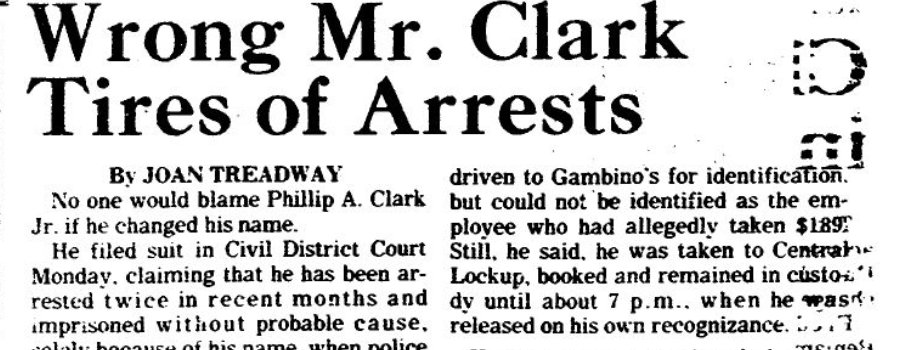
According to an April 4, 1978 article in the Times-Picayune titled, “Wrong Mr. Clark Tires of Arrests,” our unfortunate protagonist’s wife was home alone. Suddenly, two officers arrived at the door. They asked Mrs. Clark if her husband worked for Gambino’s Bakery — a question that obviously caught our attention all these years later!
Two important pieces of information they knew about the culprit was that 1) he had stolen $189 from our Gambino’s Bakery; and 2) he was also employed at the bakery! (Hey, there’s a black sheep in every family, right?)
Mrs. Clark told the police her husband had never worked at Gambino’s, but the police decided to wait for Phillip to return anyway.
When he did, he was promptly arrested.
Mistaken identity
There was one additional piece of information the police knew about their suspect. It’s that his name was Phillip Clark.
Unfortunately for Phillip A. Clark, who was now sitting in a jail cell for no good reason, it turns out there were multiple Phillip Clarks in 1970s New Orleans.
The Phillip Clark in prison was the wrong one. The Gambino’s-robbing Phillip Clark was still on the loose!
It was a classic, Shakespearian example of mistaken identity and, once it was sorted out that evening, Clark was released from prison with the promise that he’d appear for any court dates scheduled to further resolve the situation. He kept his word and the Orleans Parish District Attorney’s Office dismissed the case shortly thereafter.
Clark’s freedom, however, was short-lived. On January 14 at 2:30 am — “Nothing good happens after 2am!” they say — Clark was once again taken to jail. This time it was for a traffic charge, and it’s unclear whether or not he was actually guilty of this offense.
Here’s what wasn’t unclear: his wife came to bail him out. And, when she did, Clark’s bad luck struck again.
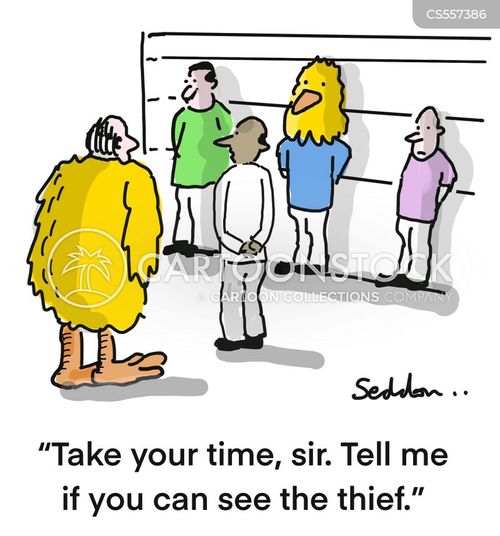
As he was going through the standard procedure of being processed out of jail, the New Orleans Police Department employee on duty saw in the system that Clark was wanted by a juvenile court for failure to pay child support.
This was an interesting situation. Not only because this was a lot going wrong for one man over a six-week span, but also because Clark’s wife was literally with him at the jail. She attempted to vouch for the fact that this was her husband and, because they were married, she should be taken at her word that he owed her no money — child support or otherwise.
The police once again had the wrong Clark. But, once again, it didn’t matter. His wife’s pleas were ignored. Clark was rearrested and rebooked, and he remained in prison for another two days.
Sorted
Finally, on the afternoon of January 16, Mrs. Clark was able to convince the judge at the juvenile court that he had the wrong man.
Clark was free! (Again.) But he understandably had had enough. The innocent man sued the City of New Orleans for lost wages, attorney’s fees, humiliation, as well as pain and suffering to the tune of $10,000. That’s more than $48,000 in today’s dollars!
He also requested an injunction prohibiting any police officers from arresting him solely on the basis of his name.
Fortunately, the guilty Phillip Clark was eventually arrested. And, while we’re pleased it cleared the name of all the other Phillip Clarks, we’re even more pleased it helped reduce the number of robberies at our sweet, peaceful bakery.
The post Would the real Phillip Clark please stand up? appeared first on Gambinos Bakery.
How a boy with a “bad heart” showed Gambino’s soul 17 Jul 2024, 3:01 pm
Gambino’s Bakery cares about its community. Our neighbors matter, and they are part of what has made our shops so special for 75 years. Bryan Thomas, the boy with the “bad heart” is one amazing and memorable example.

As we look back through the historical archives at Gambino’s 75 years serving Louisiana, it is immediately obvious that the word “serving” isn’t only in reference to the baked goods our customers have lined up to enjoy for decades.
We have also made it a point to serve our community — especially those in need.
“That’s something we’ve always prioritized and taken pride in,” said Sam Scelfo, who was once the CEO of Gambino’s Bakery. Scelfo’s family still owns the bakery, and he continues to work there most days.
“People who live in the same communities as our bakeries — those are our neighbors,” he said, “and we care about helping our neighbors however we can.”
Searching through old newspaper articles, we’ve enjoyed finding examples highlighting this spirit of community involvement.
Over the years — to name just a few examples — Gambino’s has provided refreshments for children with birth defects at a fundraiser for the March of Dimes, donated a cake for a benefit supporting local special education students, given sweets to at-risk kids on Christmas, sponsored an event to help repair the Cabildo, and provided space to local Italian-Americans so they could create their iconic St. Joseph’s Day altars. In 1973, we were honored by the governor for giving handicapped people a chance to show their skills and gain employment.
And these examples are just the tip of the iceberg.
We’ll get to some of those in future blog posts, but one we wanted to focus on today is the story of Bryan Thomas, a seven-year-old boy with “a bad heart” who, alongside his mother, played a big role at our Baton Rouge bakery in the 1980s.
Boy with the “bad heart”
An August 6, 1986 article in Baton Rouge’s paper, The Advocate, featured Bryan and his mother, Therese Bedwell:
“Bryan Thomas, 7, looks out over a pan of petit fours at Joe Gambino’s bakery. The youngster can barely reach the counter-height work tables in the bakery where he works a few hours each week.
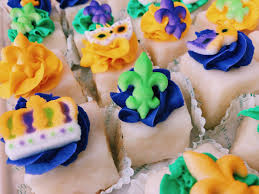
“’I make pie tops,’ says Bryan, ‘and help with the jelly cookies. You take a ball of dough, flatten it out and put jelly in the middle. Then someone takes a big pan of them and shoves it into the oven.’”
His mother, Therese, was a manager of Gambino’s Baton Rouge bakery at the time. She needed to keep Bryan close because, as the article, titled, “Bad heart lands boy in bakery,” explained, Bryan was missing a valve in his heart. As a result of the congenital condition, he couldn’t play as rigorously as boys his age usually do.
At the time of the article, Bryan had already had two operations, and was scheduled for another open heart surgery the following year. The valves in his heart were closing up, but the doctors responsible for the boy’s care needed time to research and learn about his rare condition.
Cookie monster
The compromised valves in his heart were first re-opened through heart catheterization when Bryan was just a few days old. Bryan weighed 8 pounds, 2 ounces, but found himself in the neonatal ward, next to mostly 2-pound premature infants.
Due to the noticeable size difference, nurses affectionately called Bryan, the “Cookie Monster.” It was a fitting name for a child who would eventually spend so many days at our bakery!
But those first days of life were anything but sweet for Therese’s little “Cookie Monster.” And because he was always hooked up to life support machinery, it was difficult for mother and son to bond.
“He was strapped down and connected to machines,” she said. “The medical staff had to use a suction tube like a straw to clear our congestion.”
“He would look at me and big tears would roll out of those big brown eyes,” Therese recalled. “But at 4 months he looked at me and he knew who I was.”
A big help
After his second surgery, Bryan’s condition improved. His parents ensured he had a fulfilling home life, playing with his friends and focusing on the things he could do rather than what he couldn’t.
But Therese wanted to keep her song close when he wasn’t at school. And Bryan was a big help during his time at the bakery. When someone was on the phone taking an order, for example, they would ask Bryan to make sure the needed items were in stock.
He was also great for public relations. When children accompanied their parents into the shop, Bryan would welcome them with balloons and cookies.
“I show them around,” the boy added in the article.
Bryan was rewarded for his work. His mother paid him $5 per week — plus baked goods, of course. Not a bad allowance for the 1980s!
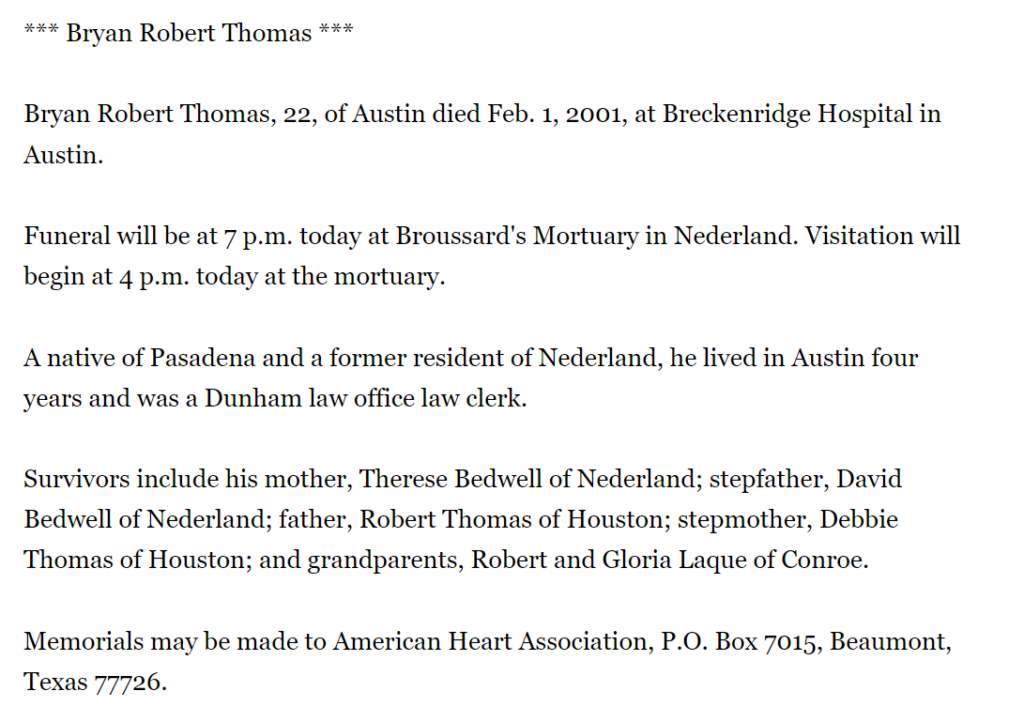
Into adulthood
Unfortunately, Bryan’s condition made it impossible to know what his future had in store. But, against the odds, the cute doughboy, running around Gambino’s in his little white apron, survived into adulthood.
He lived to be 22 years old, passing away in Austin in 2001. Fittingly, he and his mother asked that memorials be made to the American Heart Association.
In our 75 years, one consistency Gambino’s has enjoyed is an incredible team of bakery staff, making a massive difference for our customers and the cakes and pastries they have grown to love. We are grateful Bryan Thomas was a part of that history, and proud we were a small piece of his story.
The post How a boy with a “bad heart” showed Gambino’s soul appeared first on Gambinos Bakery.